Roadmap

Universe Sandbox Roadmap: 2025 & Beyond
Mar 31st
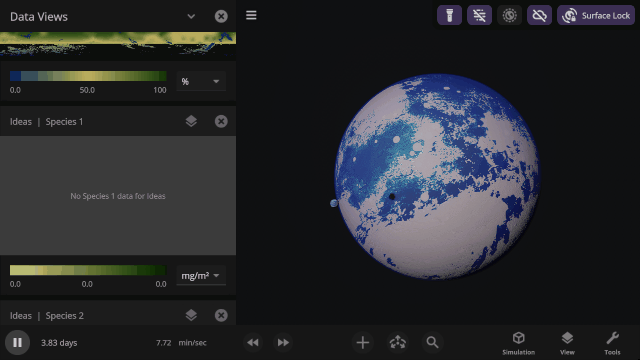
We started 2025 by releasing our major graphics overhaul, but we have much more planned for the year, including allowing meteors to burn up in an atmosphere, simulating basic life, and getting Universe Sandbox on mobile devices so you can create and destroy on the go. Before diving into details, let’s look back on some highlights from 2024.
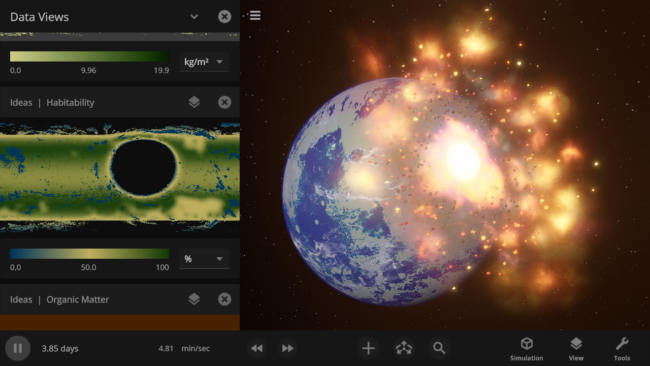
Highlights from 2024
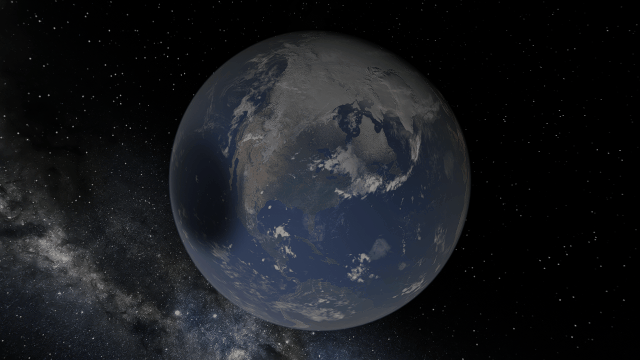
We spent 2024 working on our major graphics overhaul, released March 2025, and many of the other in-progress features mentioned in this roadmap. In addition to the awe-inspiring realistic graphics, our March graphics update included many quality-of-life improvements. Our biggest accomplishments from the year include:
- Improving material simulation and manipulation with more realistic atmosphere colors and opacity and the ability to swap one material for another. (Update 34.1, March 2024)
- Replacing our 10-year-old graphics technology with a state-of-the-art system so you can immerse yourself in a more awe-inspiring and realistic universe. (Update 35, March 2025)
- Implementing a new interface system that automatically positions, resizes, and closes panels so you can focus on manipulating the universe instead of managing panels. (Update 35, March 2025)
The new graphics rendering and user interface systems were major milestones on our 2024 Roadmap.
What’s the Plan for 2025?
Finish our major graphics update.
- Released on March 3, 2025!
- Add basic life simulation where vegetation grows, dies, and gets eaten.
- Optimize and rewrite our simulation using Unity’s Data-Oriented Technology Stack (DOTS).
- Bring Universe Sandbox to phones and tablets (iOS & Android).
We plan to work on all these projects in 2025, but some, like getting Universe Sandbox on mobile devices, have been in the works for years. Additional challenges may arise that delay features, and our priorities may change.
Even More Graphics Improvements: The Saga Continues
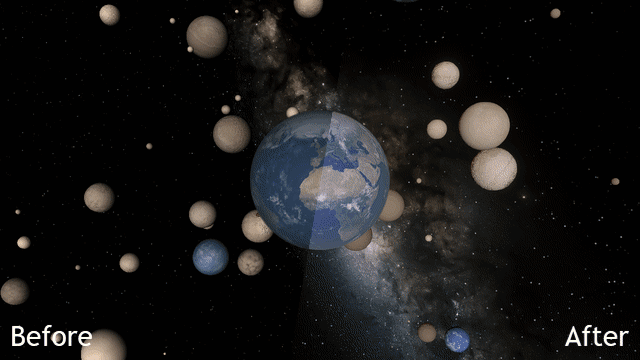
Earlier this year, we released our major graphics update with hot, non-stellar objects emitting light, physically based lighting, and more. But we’re not done yet! We’re planning even more graphics features, including object selection highlights that are unique to the object’s shape and new point light object.
- But Wait, There’s More!
- Now that our new graphics rendering system is out, we’re planning to utilize it to add even more graphics features, including
- Redesigning object selection outlines to be more visible, useful, and unique to that object’s shape instead of always being a circle.
- Adding new Point Lights with customizable colors to light up your simulations without adding stars (and boiling Earth) for that perfect shot.
- Now that our new graphics rendering system is out, we’re planning to utilize it to add even more graphics features, including
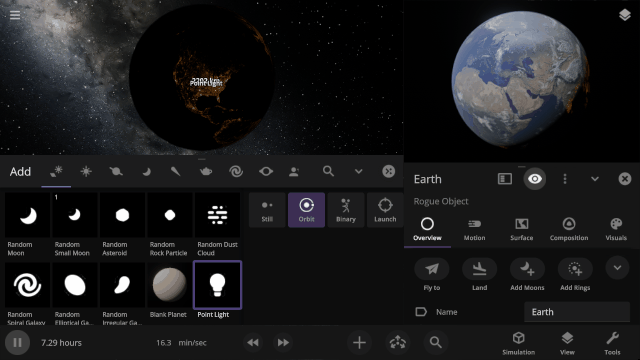
- Simulating supernovas emitting light (Spoiler – they’re really really bright).
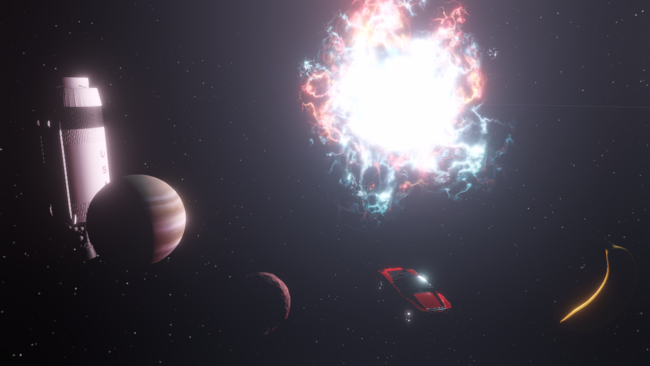
Life Simulation: Let There Be Life!
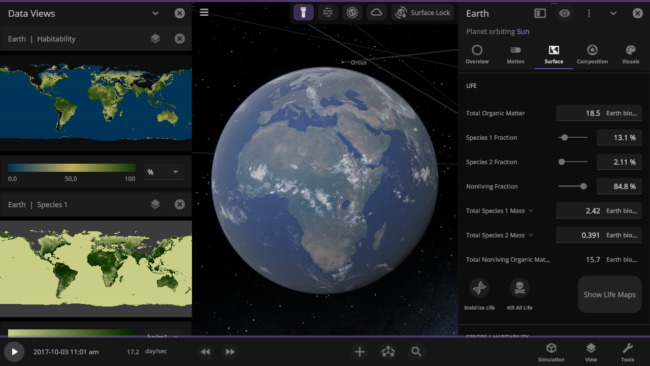
Last year, we began working on life simulation after adding materials like carbon dioxide and oxygen to planet atmospheres. Vegetation will grow, spread, die, and be eaten on planet surfaces, similarly to how we simulate temperature, liquid, and gas flow.
- Simulating Vegetation
- Life can spread to other planets on fragments from collisions.
- As vegetation grows and dies, the amount of carbon dioxide and oxygen in the atmosphere will change.
- Vegetation will grow, spread, and die based on the local conditions on the surface of a planet.
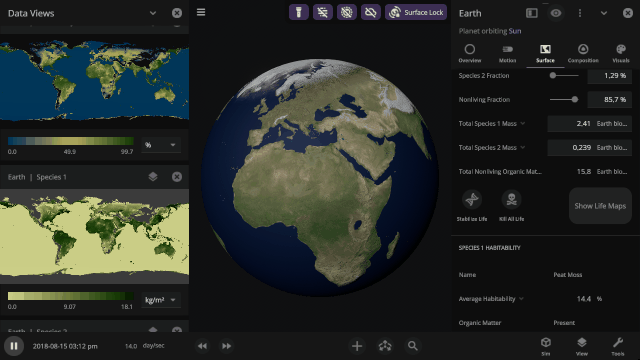
- You’ll be able to customize the conditions needed for life on your planets so your plants can absorb methane and emit hydrogen, for example.
- You can even set the conditions to make life grow on Titan!
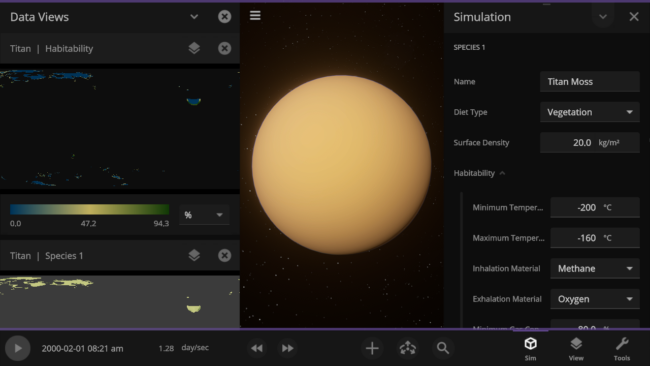
- Animals & the Circle of Life
- Herbivores, like vegetation, will also be simulated on planet surfaces. The overall herbivore mass will be tracked and will also depend on how much vegetation there is on the planet to support them.
- The names and life requirements of the two species will be customizable as well, so you can let your imagination run wild to simulate your favorite plants and animals, like cows, trees, whales, dik-diks, skunk cabbage, aliens, unicorns, you name it (literally)!
- Future Models
- We plan to make our food chain even more complex with carnivores in the future.
- You’ll be able to quickly cause catastrophic events leading to mass extinctions. For now, we have a simple Kill All Life action.
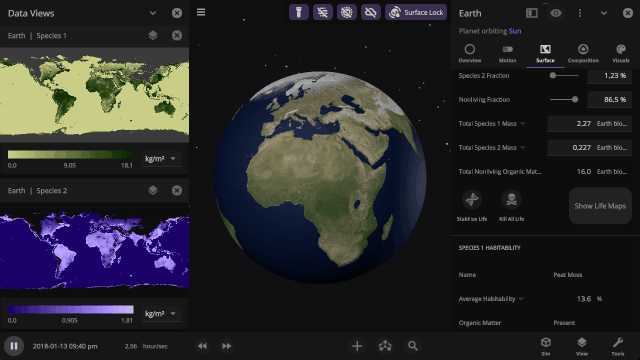
Advanced Physics Technology
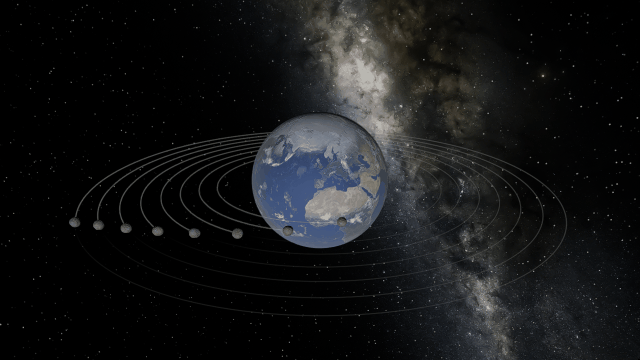
Improving collisions with more realistic friction and craters, simulating atmospheric drag, which allows meteors to burn up in the atmosphere, and continuing to optimize our physics simulation are all things we’re working on this year.
- Advanced Game Engine Features
- We’re continuing to reconstruct our simulation architecture using the Data-Oriented Technology Stack (DOTS) from Unity, the game engine we use to build Universe Sandbox. We’re excited about the expected performance gains and future opportunities it brings. We plan to roll these changes out in multiple phases.
- Phase 1 replaces our current physics engine with a new DOTS-based system that will make Universe Sandbox easier to maintain and improve.
- Upgrading to DOTS in phase 1 lays the foundation for everyday, non-spherical object collisions (like two dice), building and flying spacecraft, and constructing megastructures like Dyson spheres.
- Phase 2 will unify our collision simulation to allow for more realistic collisions of celestial objects like planets and everyday objects like pigeons. This phase will allow
- Objects to physically deform due to craters, fragmentation, laser impacts, and more, influencing how they collide.
- Everyday objects, including simple shapes like dice and complex shapes like spacecraft, to collide according to their unique forms instead of as spheres, also called rigid-body physics.
- Phase 1 replaces our current physics engine with a new DOTS-based system that will make Universe Sandbox easier to maintain and improve.
- We’re continuing to reconstruct our simulation architecture using the Data-Oriented Technology Stack (DOTS) from Unity, the game engine we use to build Universe Sandbox. We’re excited about the expected performance gains and future opportunities it brings. We plan to roll these changes out in multiple phases.
- DOTS optimizes our simulation by efficiently running more computations simultaneously on the CPU, allowing for more objects, collisions, and fragments.
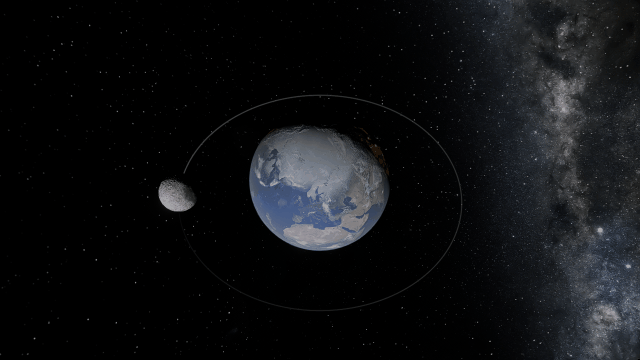
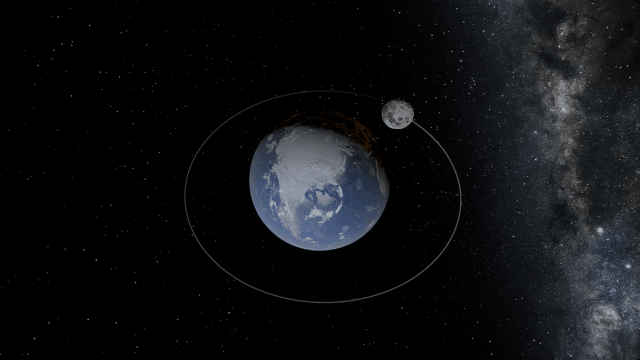
- New Gravity Simulation
- We’re experimenting with a new method of gravity simulation, called Barnes-Hut simulation, to allow rock fragments and dust clouds to attract and merge, forming planets & moons. Currently, these particles can only be pulled on and cannot form planets independently.
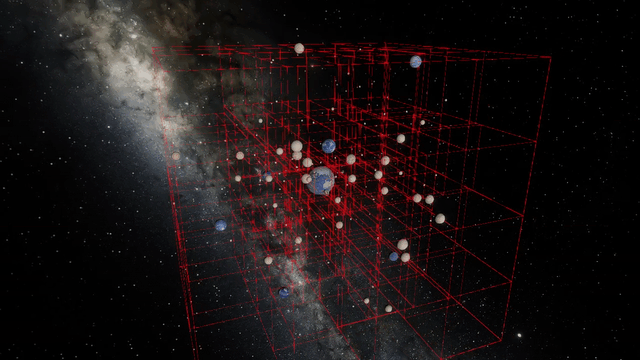
- Grinding to a Halt
- Our new friction model will simulate craters stretching out as objects skid across each other’s surfaces during collisions. In our current simplistic model, craters are always circular.
- Visually Deformed Objects
- Most objects in Universe Sandbox are spheres, but in real life, some rotate so quickly that they stretch and flatten, like the dwarf planet Haumea. We’re working to simulate this stretching visually.
- This will not affect the object’s physical shape, collisions, or surface simulation until after Phase 2 of our restructuring our simulation with DOTS is complete.
- Most objects in Universe Sandbox are spheres, but in real life, some rotate so quickly that they stretch and flatten, like the dwarf planet Haumea. We’re working to simulate this stretching visually.
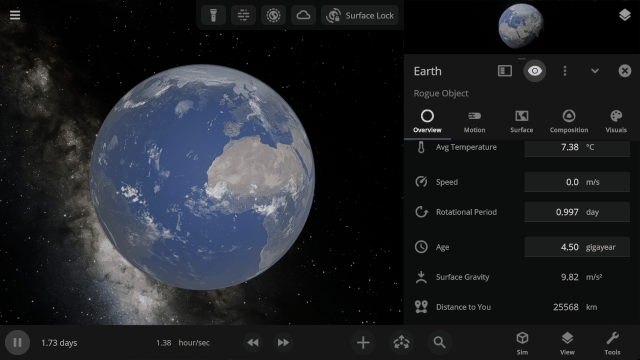
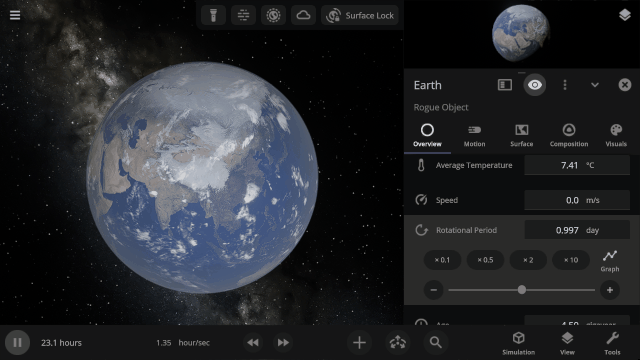
- Atmospheric Drag
- To simulate meteors, we’re working on adding a drag force so objects burn up while traveling through a planet’s atmosphere. Currently, objects pass through atmospheres unchanged.
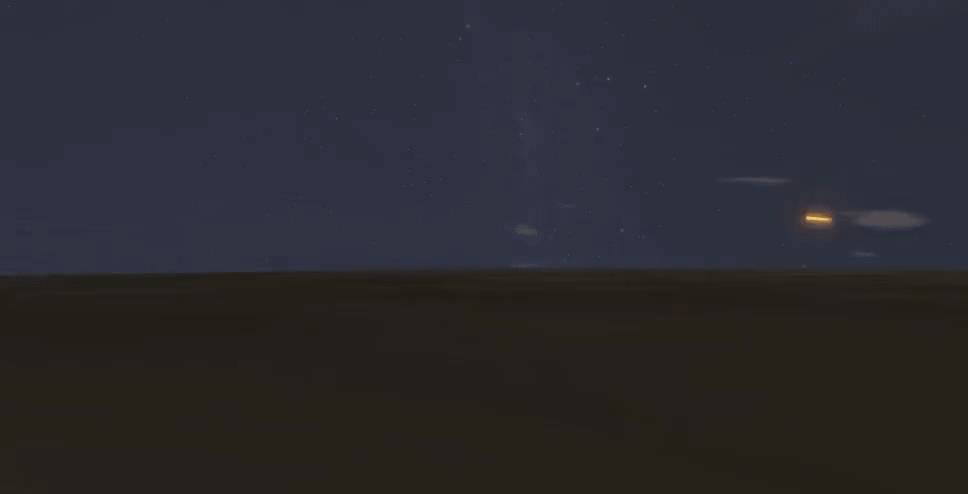
- Tidal Locking
- We’re planning to simulate objects becoming tidally locked, where the same side of one always faces the other as they orbit each other, like the Moon to the Earth.
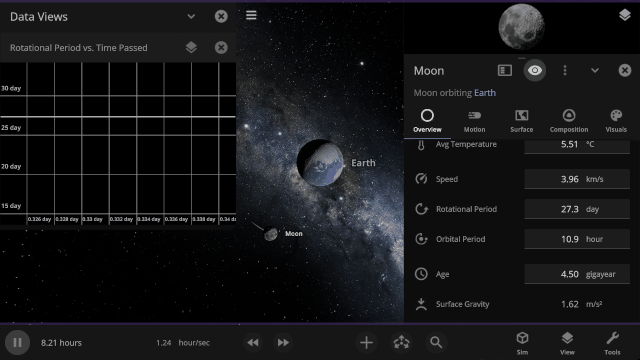
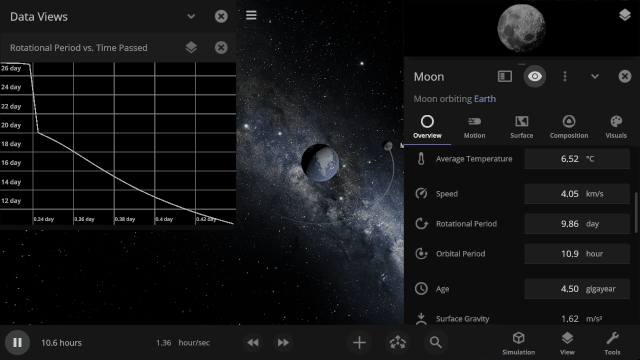
- Mathematical Points
- We’re planning to add more visualizations of useful mathematical points and boundaries, including
- Lagrange Points – the points where the gravitational influence of two objects is equally strong. Objects placed at these points orbit in a stationary position relative to the two objects like the James Webb Space Telescope is to Earth and the Sun.
- Hill Spheres – the boundary within which a moon is gravitationally bound to a planet.
- Roche Limit – the boundary where the tidal forces pulling on an orbiting object are stronger than its self-gravity, ripping it apart.
- We’re planning to add more visualizations of useful mathematical points and boundaries, including
Universe Sandbox on Phones & Tablets
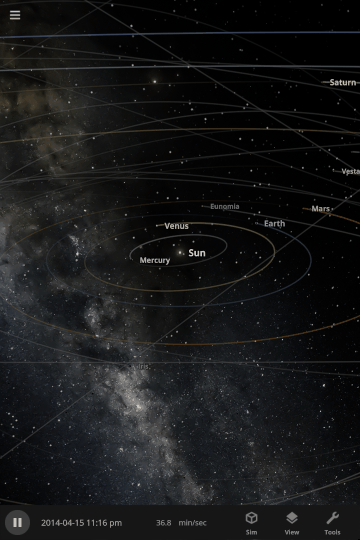
Getting Universe Sandbox on mobile devices (iOS & Android) is a major focus again this year. We’ve made a lot of progress with our new graphics update and interface system, which significantly improves usability on small touchscreens, but there’s still a lot to do.
- Small Screen Interface
- Our new interface system automatically positions, resizes, and closes panels so you can always see the simulation. This system optimizes interface usability for any screen size, from small touch screens to ultrawide monitors and we’re planning to continue improving and polishing it this year.
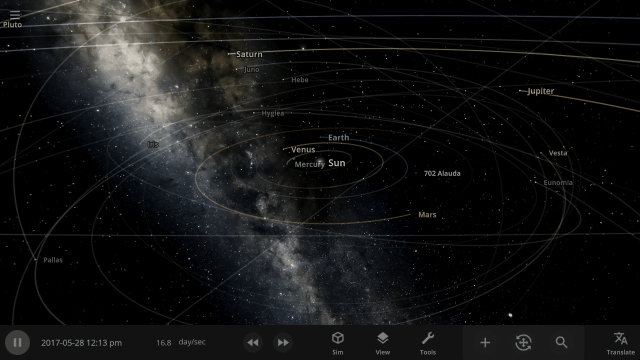
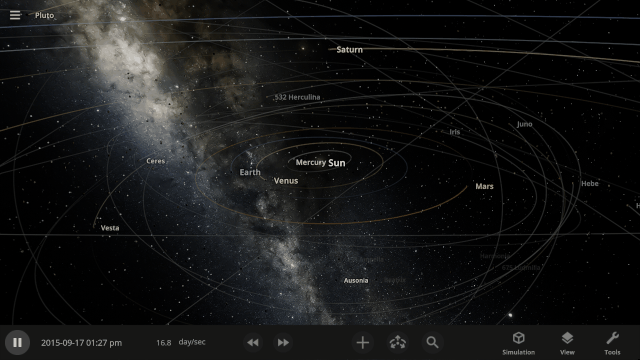
- Running the Universe
- Boosting performance across all platforms is another mobile requirement. We’ve been improving interface responsiveness, resource utilization, and optimizing start-up times.
- Rebuilding our simulation architecture will also bring necessary performance boosts to desktop and mobile devices alike.
- Automated Test Suite
- We’re expanding our automated tests, which cover collision physics, simulation performance, and more, and the ways we compare their results, to help us catch and fix bugs across desktop and mobile devices faster.
- More Information
- Universe Sandbox on mobile is built from the same codebase as the desktop version and will have the same features.
- There is no mobile release date yet.
- We plan on it being a one-time paid app with no ads or in-game purchases.
- Price is not finalized.
- Minimum requirements are not finalized.
- Sign up for our mobile mailing list to receive updates about mobile development
http://universesandbox.com/mobile/
And Beyond
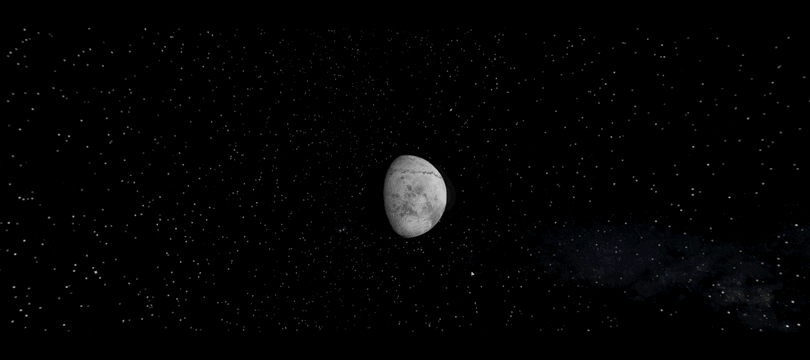
Our future goals include adding detailed planet surfaces, simulating the life cycle of a star, and allowing you to use custom elevation maps and textures on your planets. These are in early development, and we don’t know when they will be released.
- Detailed Planet Surfaces
- Imagine flying over mountains and through canyons on planet surfaces in Universe Sandbox. We’re still experimenting with ways to add more details to planet surfaces, but we’re excited about the possibilities.
- Imagine flying over mountains and through canyons on planet surfaces in Universe Sandbox. We’re still experimenting with ways to add more details to planet surfaces, but we’re excited about the possibilities.
- Planet Customization
- We want to give you even more control over planet appearances. Satisfy your world-building desires and create a planet using custom maps or images, like a picture of your dog.
- We want to give you even more control over planet appearances. Satisfy your world-building desires and create a planet using custom maps or images, like a picture of your dog.
- Stellar Lifecycles
- Realistically simulating how stars burn hydrogen into helium (and heavier elements) and die violent deaths is complex, but we’re planning to rebuild our star simulation so we can bring stellar evolution to Universe Sandbox.
- Realistically simulating how stars burn hydrogen into helium (and heavier elements) and die violent deaths is complex, but we’re planning to rebuild our star simulation so we can bring stellar evolution to Universe Sandbox.
- Volatiles
- To simulate comet tails streaking through space, we plan to overhaul our volatile system, which determines how gas escapes from a planet’s atmosphere into space.
- To simulate comet tails streaking through space, we plan to overhaul our volatile system, which determines how gas escapes from a planet’s atmosphere into space.
- Gamepad and Steam Deck
- What could be better than playing Universe Sandbox from the comfort of your couch? We’re working on adding gamepad support for more ways to control your universe. This will improve our Steam Deck support and has the potential to support other gamepad-based consoles in the future.
We’re excited to bring so much to Universe Sandbox this year, and we can’t wait to share it with you!

Universe Sandbox Roadmap: 2024 & Beyond
Mar 18th
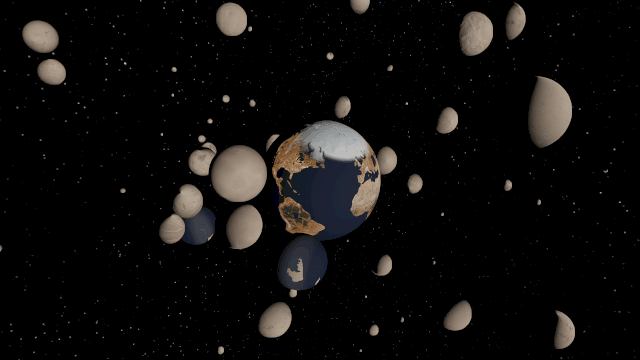
This year’s plans include a major graphics overhaul, more realistic collisions & craters, and putting Universe Sandbox on mobile devices so you can create and destroy on the go. Before getting into the details, here’s a brief recap of last year.
Highlights from 2023
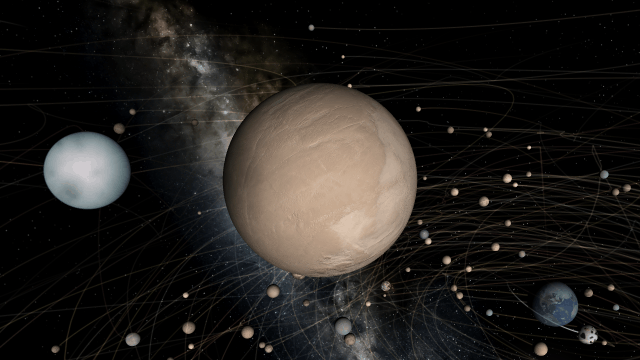
In 2023, we put out 4 feature-packed updates. Some of our favorite new additions include
- Massive improvements to our gravity simulation’s accuracy, stability, and performance.
- Adding 8 new materials, including oxygen & carbon dioxide, to realistically simulate, construct, and terraform planets and atmospheres.
- Rolling a Spherical Cow into Universe Sandbox. This refers to a joke that physicists sometimes oversimplify real-world problems to make them easier to solve.
The gravity simulation improvements and additional materials were major milestones from our 2023 Roadmap post. Check out our 2023 Retrospective post for more on what we did last year.
What’s the Plan for 2024?
- Using a new graphics renderer to immerse you further in the universe with bright glows, smoothly drifting dust clouds, and more.
- Optimizing our simulation performance with Unity’s Data-Oriented Technology Stack (DOTS).
- Doubling down on our efforts to bring Universe Sandbox to phones and tablets (iOS & Android).
- Begin adding basic plant-based life simulation.
- Continue improving our development tools to find and fix issues quickly.
We plan to work on all of these projects in 2024, but some, like our new graphics renderer, have been in the works for a while. Additional challenges may arise that delay features, and our priorities may change.
New Graphics: A Visual Glow-Up
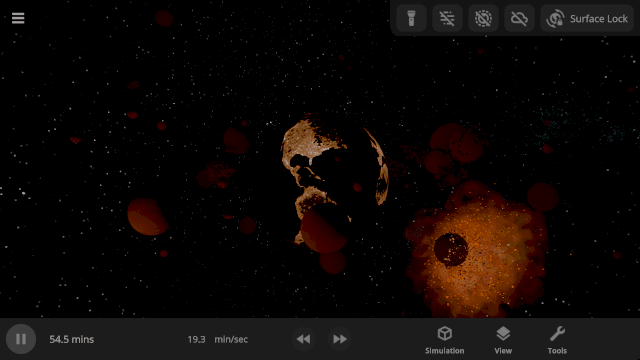
It’s time for a glow-up, literally. We’re rebuilding our graphics rendering from the ground up. After our overhaul, only the hot parts of the objects will glow instead of the entire object, dust clouds will blend smoothly with other objects, and more.
- New Graphics Renderer
- Last year, we started transitioning our graphics rendering to Unity’s Universal Render Pipeline (URP). This system allows us to use more true-to-life light properties and easily add and maintain new graphical elements. We’re expecting a performance boost too.
- Dust clouds passing through planets currently show sharp lines at their intersection. URP will let us render transparent clouds that blend smoothly with planets, called soft particles.
- Last year, we started transitioning our graphics rendering to Unity’s Universal Render Pipeline (URP). This system allows us to use more true-to-life light properties and easily add and maintain new graphical elements. We’re expecting a performance boost too.
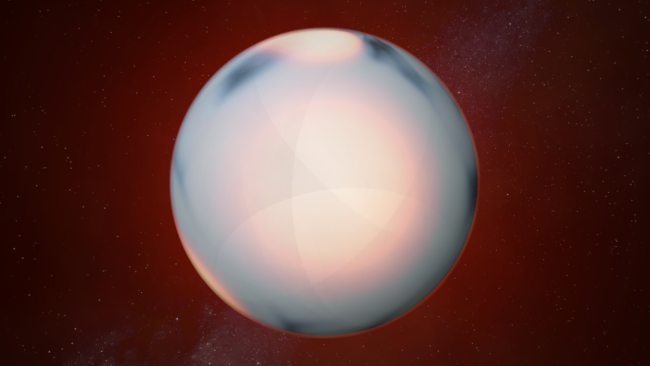
- Planets will glow only where their surfaces are hot, with hot spots from lasers and colliding objects only glowing at the impact site. Currently, planets glow uniformly based on their average temperature.
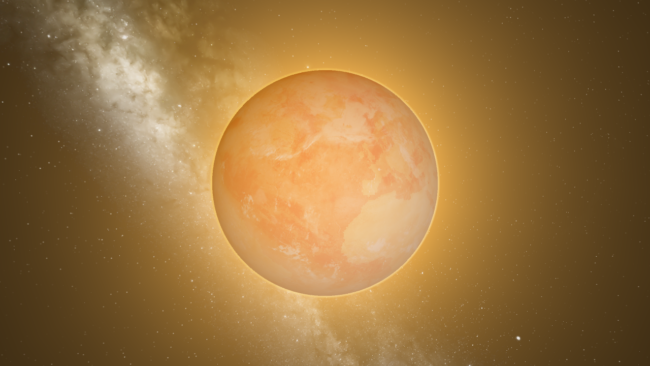
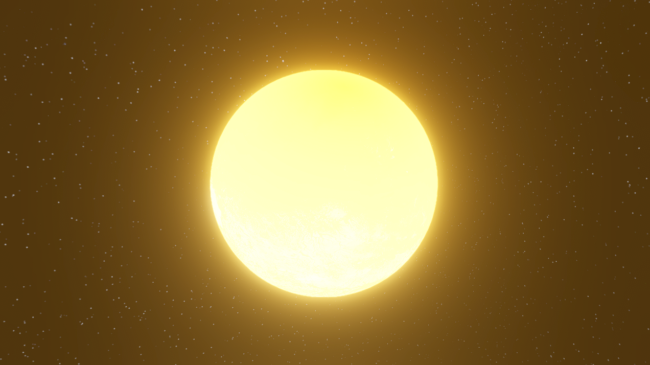
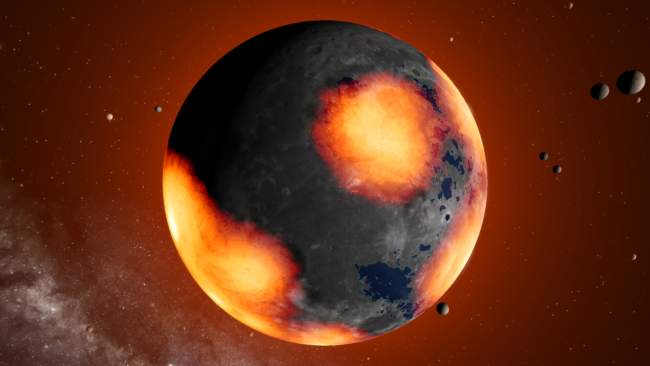
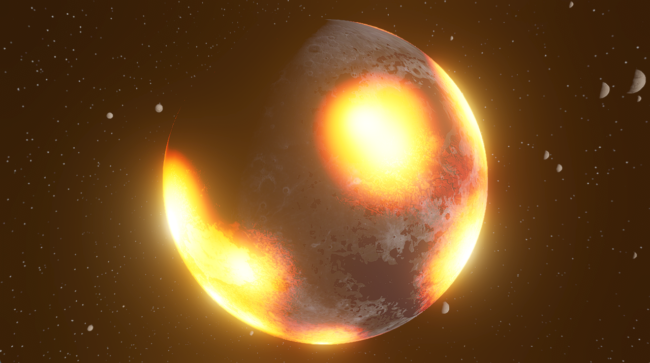
- Eventually, we’ll simulate objects casting shadows on themselves, like the solar panels on a spacecraft casting a shadow on its body.
- Lighting Up Space
- Light – it’s not just for stars anymore. Hot planets will emit light based on their temperature so you can light up your simulation with intense impacts.
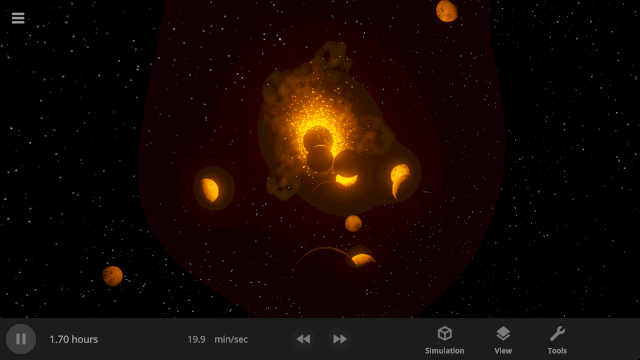
Physics: Collisions, Gravity, & Performance (Oh My)
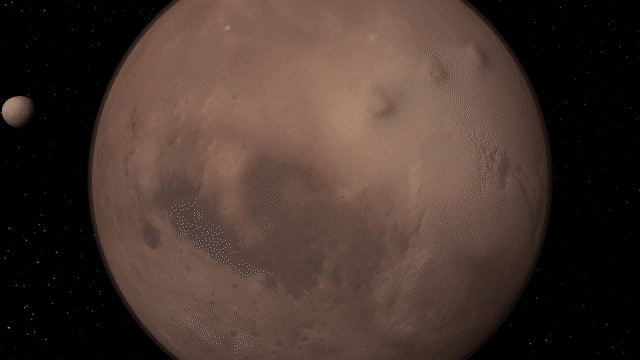
Improving collisions and their aftermath, like impact craters and ejecta, and continuing to optimize our physics simulation are all improvements we’re working on this year.
- Advanced Game Engine Features
- We’re continuing to reconstruct our simulation architecture using the Data-Oriented Technology Stack (DOTS) from Unity, the game engine we use to build Universe Sandbox. We made good progress last year and are excited about the expected performance gains.
- DOTS optimizes our simulation by efficiently running more computations simultaneously on the CPU, which means simulating more objects, collisions, and fragments at once.
- This transition will effectively combine parts of our simulation, like how different types of objects are defined, making it easier to maintain without sacrificing complexity.
- We’re continuing to reconstruct our simulation architecture using the Data-Oriented Technology Stack (DOTS) from Unity, the game engine we use to build Universe Sandbox. We made good progress last year and are excited about the expected performance gains.
- Grinding to a Halt
- Our new friction model will simulate craters stretching out as objects skid across each other’s surfaces during collisions. In our current simplistic model, craters are always circular.
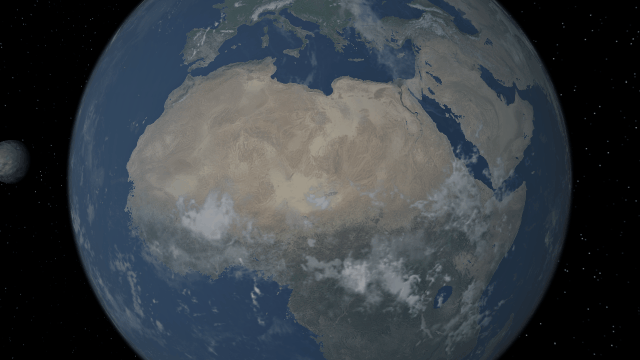
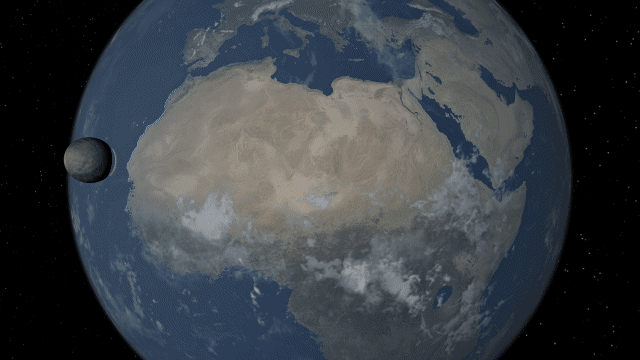
- To simulate meteors, we’re working on adding a drag force so objects burn up while traveling through a planet’s atmosphere. We’re also exploring ways to apply this force to objects passing through gas clouds and liquids. Currently, objects pass through atmospheres unchanged.
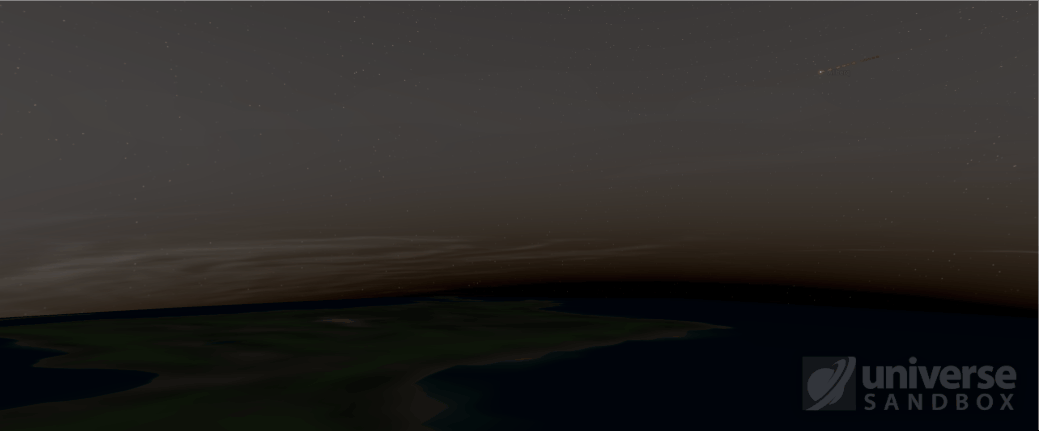
- Chaotic Consequences
- Rock fragments and gas clouds are created when planets collide or are vaporized, but computer limitations mean we sometimes need to remove the old ones to create new ones. We’re testing better removal methods to immerse you in the chaos. This was released in March as part of Update 34.1.
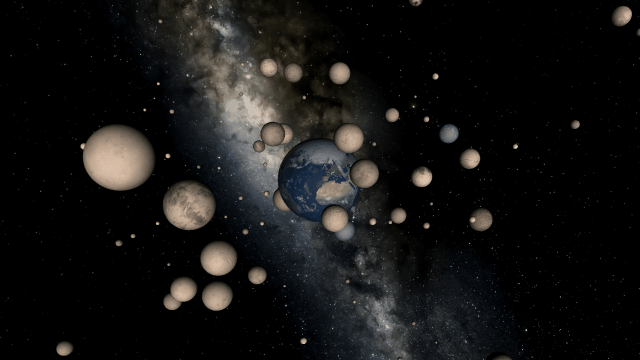
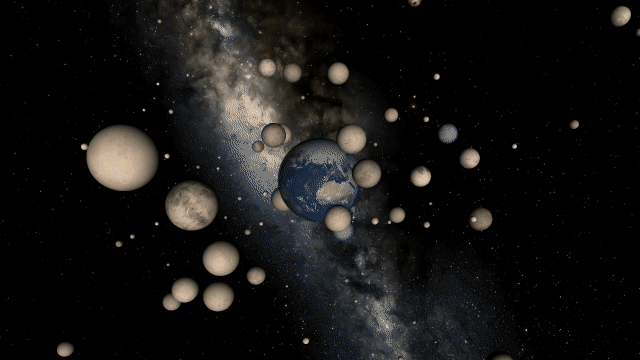
- New Gravity Simulation
- We’re experimenting with a new method of gravity simulation to allow rock fragments and dust clouds to attract and merge, forming planets & moons. Currently, these particles can only be pulled on and cannot form planets independently.
- We’re experimenting with a new method of gravity simulation to allow rock fragments and dust clouds to attract and merge, forming planets & moons. Currently, these particles can only be pulled on and cannot form planets independently.
- Smooth Object Transitions
- If the Sun gets too massive in Universe Sandbox, it instantly shrinks into a black hole. In real life, this shrinking and compression takes time. We’re updating our simulation so these transitions can occur on realistic timescales.
- We hope to simulate the answer to the question, “What if you filled the Solar System with soup out to Jupiter?” (Spoiler: The soup would contract into a supermassive black hole in about 30 minutes.)
- If the Sun gets too massive in Universe Sandbox, it instantly shrinks into a black hole. In real life, this shrinking and compression takes time. We’re updating our simulation so these transitions can occur on realistic timescales.
Universe Sandbox on Phones & Tablets
Getting Universe Sandbox on mobile devices (iOS & Android) is a major focus. We’re continuing to optimize our interface for small touch screens, and you can read about the latest mobile developments in our second Mobile DevLog.
- Small Screen Interface
- Unity’s cross-platform capabilities let us easily bring the same simulation changes to mobile devices and desktops.
- Our biggest challenge with mobile development is adapting our interface to work well on small touch screens (like a phone). Development is underway to intelligently resize, hide, and reveal panels as needed so you can focus on cosmic creation instead of managing the user interface.
- Unity’s cross-platform capabilities let us easily bring the same simulation changes to mobile devices and desktops.
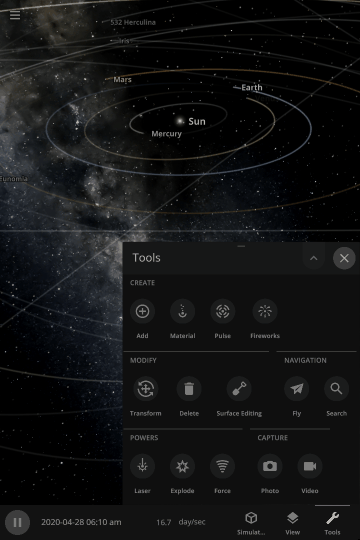
- Running a Universe
- Another requirement for mobile is boosting performance across all platforms. Alongside our new graphics renderer and rebuilding our simulation architecture, we’re improving interface responsiveness and resource utilization and optimizing start-up times, among other things.
- Another requirement for mobile is boosting performance across all platforms. Alongside our new graphics renderer and rebuilding our simulation architecture, we’re improving interface responsiveness and resource utilization and optimizing start-up times, among other things.
- More Information
- Universe Sandbox on mobile is built from the same codebase as the desktop version and will have the same features.
- There is no mobile release date yet.
- We plan on it being a one-time paid app with no ads or in-game purchases.
- Price is not finalized.
- Minimum requirements are not finalized.
- Sign up for our mobile mailing list to receive updates about mobile development
http://universesandbox.com/mobile/
Surface Simulation: Let There Be Life
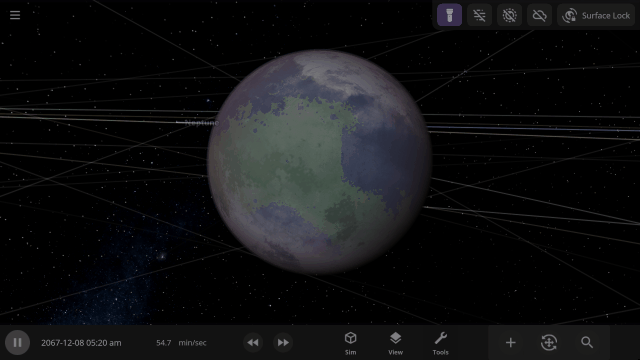
Now that we’re simulating materials like oxygen and carbon dioxide on planet surfaces, we can begin working on basic life simulation. Life will grow (and die) on these surfaces in real-time, the same way we simulate temperature, liquids, and gasses flowing.
- Basic Beginnings
- Initially, we plan to simulate just plant life, with vegetation growing, spreading, and dying based on the planet’s temperature, atmosphere pressure and composition, and more.
- As life develops, we’ll simulate how it affects the oxygen and carbon dioxide in the atmosphere, also known as a biosignature.
- Initially, we plan to simulate just plant life, with vegetation growing, spreading, and dying based on the planet’s temperature, atmosphere pressure and composition, and more.
- An Evolving Model
- Long term, we plan to add more varieties of life, like herbivores and carnivores, and simulate their interactions as a food chain develops.
- Eventually, you’ll be able to cause catastrophic events leading to mass extinctions and customize life conditions, like the amount of oxygen required for life to develop.
- Life will spread across planets’ surfaces after being Planetscaped onto a planet or appearing spontaneously. It will even spread to other planets on fragments from collisions.
- Long term, we plan to add more varieties of life, like herbivores and carnivores, and simulate their interactions as a food chain develops.
Upgrading Our Developer Toolkit

We’ve also been improving the tools we use to create and test Universe Sandbox for faster updates and bug fixing.
- Parallel Sandbox Construction
- Our newest automatic build system, which creates a new version of Universe Sandbox in the cloud whenever one of our team members changes the code, can make up to 10 versions at once.
- When many of us are making changes, this automation lets us test any new version within 30 minutes.
- When many of us are making changes, this automation lets us test any new version within 30 minutes.
- Each store that sells Universe Sandbox has slightly different requirements, so making multiple versions at once lets us release new updates almost simultaneously to all stores, like Steam and Epic. This process previously took a few hours.
- This new system will also create and deploy Universe Sandbox to mobile devices for testing on phones and tablets (iOS and Android).
- Our newest automatic build system, which creates a new version of Universe Sandbox in the cloud whenever one of our team members changes the code, can make up to 10 versions at once.

- Automation
- Expanding our automated test suite, which covers collision physics, simulation performance, and more, helps us catch and fix bugs faster.
- We’re exploring programmatic ways to compare test results to accelerate issue identification.
- We’re exploring programmatic ways to compare test results to accelerate issue identification.
- Producing and capturing game trailers and screenshots entirely in-game with a single button lets us easily show off the latest developments, like our upcoming new graphics renderer. New screenshots generated this way are already on our Steam store page, and we’re planning to release our updated trailer as an in-game guide.
- Expanding our automated test suite, which covers collision physics, simulation performance, and more, helps us catch and fix bugs faster.
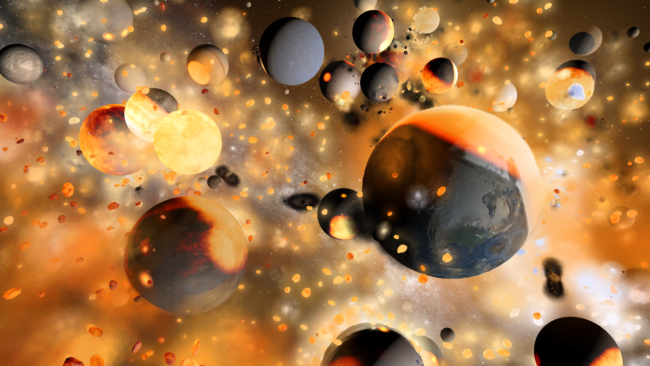
Updating Our Minimum Requirements
To adopt the latest technologies needed to restructure our simulation architecture and use our new graphics renderer, we plan to update our minimum requirements this year to include
- 4 GB dedicated video memory (up from 2 GB). 8 GB will be recommended.
- Apple: Silicon CPU (M1 or newer), meaning that Intel Mac will no longer be supported.
- Windows: Direct X version 12
While it is never fun to have support dropped, these new technologies will allow us to improve performance and add new features to Universe Sandbox now and well into the future.
We’ll ensure all users affected by this change can always access the version of Universe Sandbox from before this minimum requirements update.
And Beyond
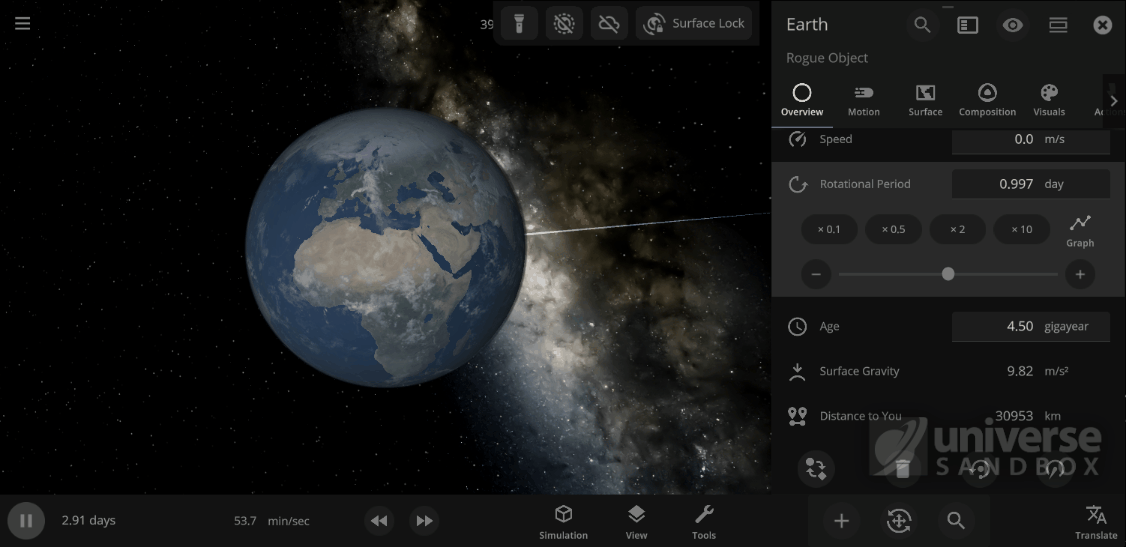
Our future goals include realistically colliding everyday objects, like a watermelon and a sledgehammer, adding detailed planet surfaces, and properly simulating comet tails. These are in early development, and we don’t know when they will be released.
- Stretch it Out
- Most objects in Universe Sandbox are spheres, but in real life, some rotate so quickly that they stretch and flatten, like the dwarf planet Haumea. We’re working to simulate that stretching.
- Most objects in Universe Sandbox are spheres, but in real life, some rotate so quickly that they stretch and flatten, like the dwarf planet Haumea. We’re working to simulate that stretching.
- Everyday Object Collisions
- Currently, when objects collide, they’re treated as spheres. We’re working on adding new physics so that everyday objects, including simple shapes like dice and complex shapes like spacecraft, will collide according to their unique forms. This is often known as rigid body collision physics.
- Currently, when objects collide, they’re treated as spheres. We’re working on adding new physics so that everyday objects, including simple shapes like dice and complex shapes like spacecraft, will collide according to their unique forms. This is often known as rigid body collision physics.
- Detailed Planet Surfaces
- Imagine flying over mountains and through canyons on planet surfaces in Universe Sandbox. We’re still experimenting with ways to add more details to planet surfaces, but we’re excited about the possibilities.
- Imagine flying over mountains and through canyons on planet surfaces in Universe Sandbox. We’re still experimenting with ways to add more details to planet surfaces, but we’re excited about the possibilities.
- Volatiles
- To simulate comet tails streaking through space, we plan to overhaul our volatile system, which determines how gas escapes from a planet’s atmosphere into space.
We’re excited to bring so much to Universe Sandbox this year, and we can’t wait to share it with you!

Universe Sandbox Roadmap: 2023 & Beyond
Mar 31st
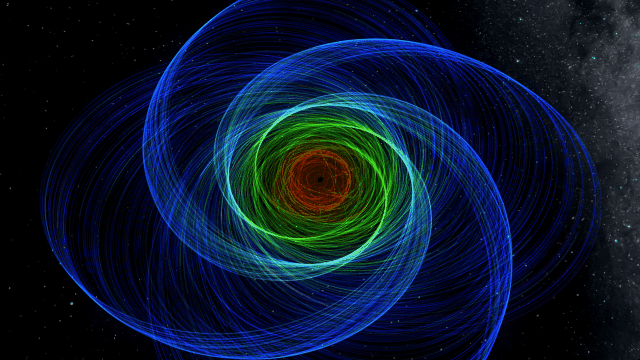
We’re working to give you more power to understand and control the complex phenomena of the universe. Our roadmap for 2023 includes simulating the lakes of liquid methane on Titan, hot planets emitting light, and realistically colliding spacecraft and bananas. But before we dive in, let’s recap some accomplishments from last year.
Highlights From 2022
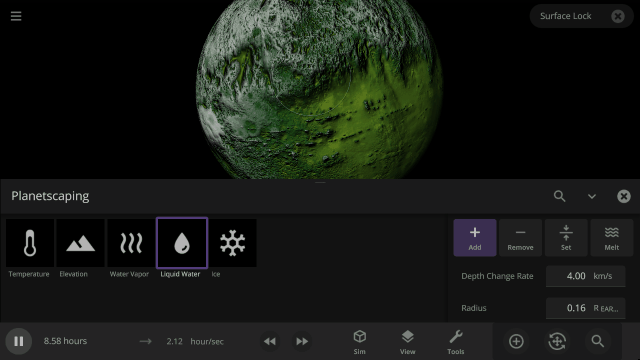
In 2022, we put out 9 updates for Universe Sandbox. These included many new features, but some of our favorites are
- Spinning up planets so fast they break apart using the new Force Spin tool
- Exploring constellations for 10 different cultures
- Customizing the look and topography of planets and moons with a library of realistic color and height maps
- Fundamental improvements to our planetary collision system
Check out our 2022 Retrospective for more on what we did last year.
So What’s the Plan for 2023?
- Add more materials for constructing & simulating planets & atmospheres
- Overhaul our under-the-hood physics architecture to improve accuracy and performance
- Simulate light emission from hot planets
- Continue work on bringing Universe Sandbox to phones and tablets
- Improve our development tools to identify issues quickly and provide a more bug-free experience
Many of our projects, like bringing Universe Sandbox to phones and tablets, have been in development for months or years. While we plan to work on everything we discuss here in 2023, complications may cause features to be delayed, and our priorities may change.
More Materials & Composition Simulation
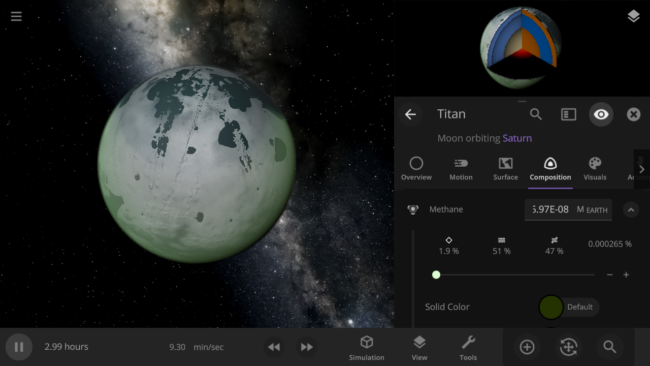
We’re expanding the number of materials in Universe Sandbox you can use to simulate, construct, and terraform planets and atmospheres realistically. For example, new materials like methane will allow us to fully simulate lakes of liquid methane on Titan. We’re also adding advanced simulation to compute planet radii based on the pressure and temperature of each material in the planet’s composition. Ever wonder how big the Moon would be if it were made entirely of oxygen? Soon you’ll be able to find out.
- A (Multi) Material World
- Planet radii and atmospheres will be realistically simulated based on the mass and phase (solid, liquid, and gas) of each material in their composition.
- Simulation of an atmosphere’s heating (the greenhouse effect), color, and opacity, including Venus-like atmospheres, will be based on their material composition.
- Designing the properties, data views, and tools for you to construct atmospheres, build and terraform planets, and track these materials is a crucial part of our development process.
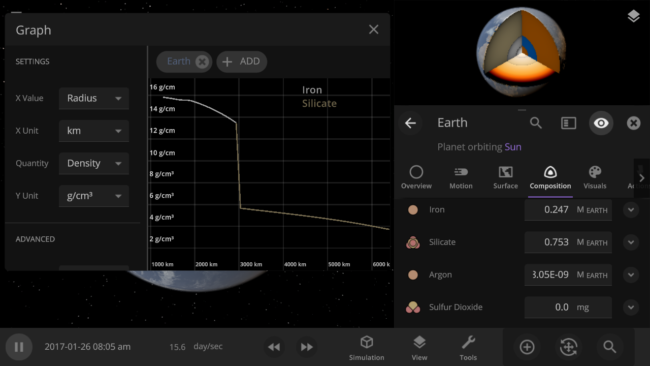
- Physics-based Phases
- The phase of each material in a planet’s composition will be realistically determined based on its pressure and temperature. Make a planet entirely out of water and see the phases from the inside out (our current model says it would be 100% liquid inside).
- Material phase models are based on geological and astrophysical measurements and research.
- Planet radii will then be calculated based on the phase and density of each material that makes up a planet’s composition. If you change the composition, the radius will change with it.
- The phase of each material in a planet’s composition will be realistically determined based on its pressure and temperature. Make a planet entirely out of water and see the phases from the inside out (our current model says it would be 100% liquid inside).
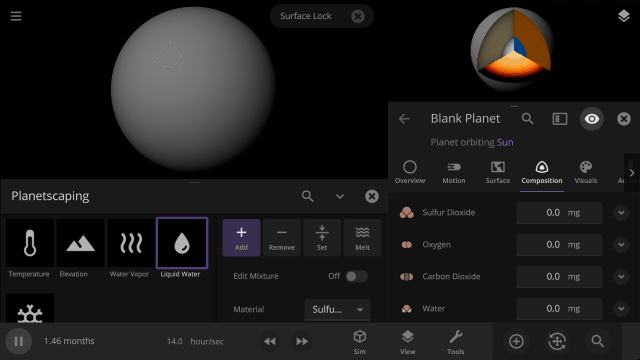
- Tracking Materials
- Materials will have customizable colors based on their physical properties that will blend on the surface of objects. Watch oceans of methane mix with oceans of oxygen in real time.
Physics Fundamentals
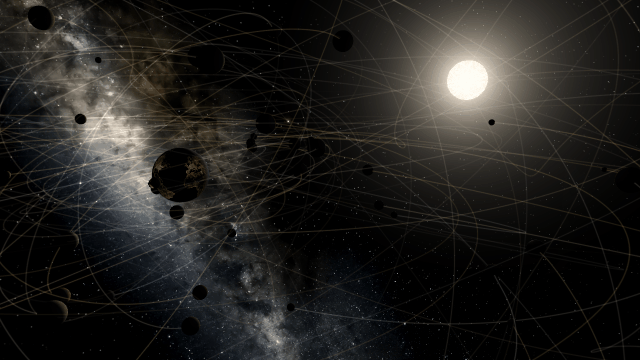
Our project to add everyday object collisions, like throwing a banana at a car, led us to first rewrite our physics architecture. Realistically smashing satellites together is part of continuous efforts to improve the realism and performance of Universe Sandbox.
- New Physics Architecture
- Overhauling our custom N-body (gravity) simulation will improve gravity-related accuracy, stability, and performance. Tight orbits like the Hubble Space Telescope around Earth should be stable at simulation speeds as high as a month per second (instead of a few days).
- These updates are the foundation for future physics improvements, like spaceships.
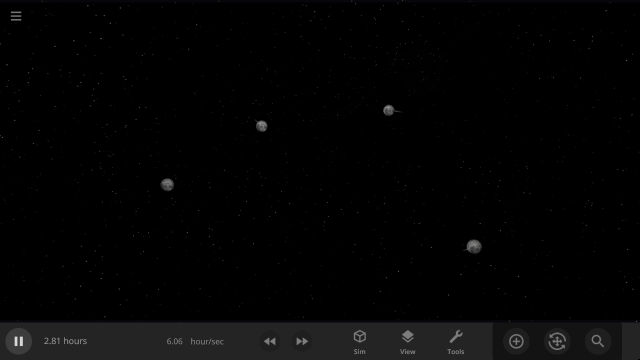
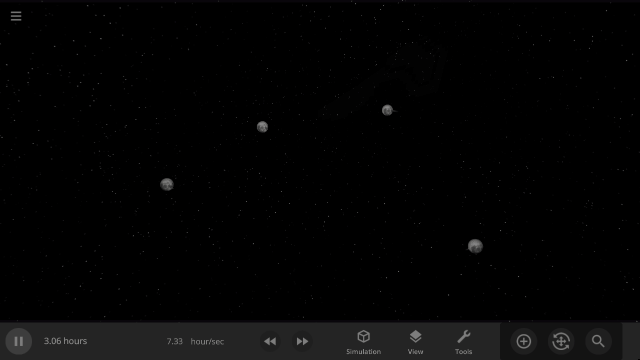
- Everyday Object Collisions
- Currently, when objects collide, they’re treated as spheres. We’re working on adding new physics so that everyday objects, simple shapes like dice and pyramids, but also complex shapes like sledgehammers and spacecraft, will collide according to their unique forms. This is often known as rigid body collision physics.
- Improved Planetary Collisions
- We’re researching methods to allow objects to stretch and deform, like two fluids mixing, during collisions, to improve upon the sphere absorbing method we currently use. Stay tuned for a status update later this year.
- Meteors & Shooting Stars
- To simulate meteors and shooting stars, we’re working on allowing objects to burn up while traveling through a planet’s atmosphere. We’re exploring ways of applying this drag force to objects passing through gas clouds and liquids too. Currently, atmospheres have no effect on objects as they pass through them.

- Advanced Game Engine Features
- As an ongoing project to optimize our simulation, we’re transitioning to the Data-Oriented Technology Stack (DOTS) from Unity, the game engine we use to build Universe Sandbox. We’re excited about the expected performance gains.
Lights in Space
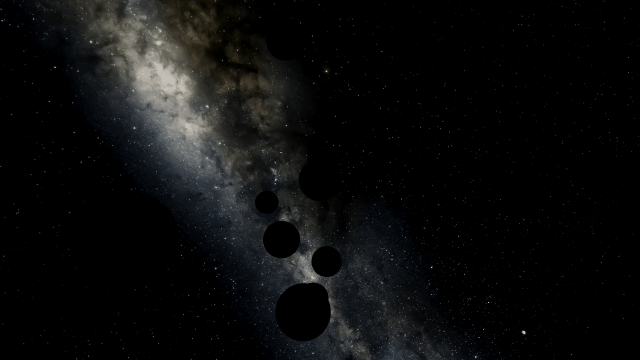
We want to light up the universe – by allowing hot planets and moons to emit light. We’re also planning a massive graphics overhaul that will change how you see the Universe (Sandbox).
- Light ‘em Up
- Light – it’s not just for stars anymore. Hot planets will emit light based on their temperature so you can light up your simulation by setting Earth to 1000 °C.
- This lighting system will eventually allow you to place and customize lights anywhere in the simulation so you can illuminate your universe without stars.
- Untitled Graphics Overhaul
- We don’t want to say too much yet, but we’re working on a massive update to our graphics system that the whole team is very excited about.
Universe Sandbox on Tablets & Phones
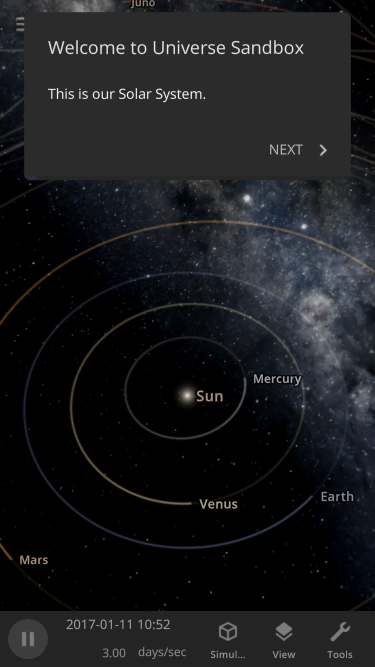
We’re stepping up our development for Universe Sandbox on mobile devices (for iOS and Android) after some delays last year. You can read about our plans in our first Mobile DevLog, and be on the lookout for more updates in the future.
- Small Screen Experience
- The primary obstacle in mobile development is adapting our interface that works well on a large screen to work on a small touch screen (like a phone).
- We’re building a system to intelligently resize, hide, and reveal panels as needed. Our goal is to reduce the need for you to spend time managing the user interface so you can focus on bending the simulation to your will.
- All of the Above
- Universe Sandbox on mobile is built from the same codebase as the desktop version and will have the same features.
- Performance is also critical, and we’re working to make Universe Sandbox run smoothly on mobile devices no matter the simulation.
Enhancing Our Developer Toolkit
We’re creating new internal tools to make developing and releasing updates of Universe Sandbox faster. These include systems to analyze your feedback and automate testing for bugs and issues.
- Testing 1, 2, 3
- Creating tests that run automatically to check our collision physics, simulation performance, and more will help us catch issues before they’re released. These tests record data and images we can use to find bugs more easily.
- Tracking Feedback
- Your in-game feedback and issue reports help us improve Universe Sandbox, and there’s a lot to review. We’re transitioning to a new system to sort and analyze your feedback more efficiently.
- Building the Sandbox
- We’ve revamped our automated build system. This system creates a new version of Universe Sandbox in the cloud every time a change is made by one of our team members.
- This automation saves each of us 10-15 minutes each time we want to review a change.
- With a single button, we can also release new updates to all digital stores that sell Universe Sandbox. This process used to take many hours and involved dozens of manual steps, so this makes it possible to release more updates faster.
- This new system easily makes versions of Universe Sandbox we can test on phones and tablets (iOS and Android) too.
- We’ve revamped our automated build system. This system creates a new version of Universe Sandbox in the cloud every time a change is made by one of our team members.
- New Trailer
- We’re producing a new Universe Sandbox trailer fabricated entirely in-game. We’ll be able to capture it with a single button press, making it easier to iterate on the trailer over time to show off the latest features and improvements.
- You will be able to play this new trailer inside Universe Sandbox, breaking out of it to experiment or explore every shot and simulation.
And Beyond

We’re always thinking about the future of Universe Sandbox. Our longer-term goals include gamepad support, life simulation, and more planet customization options. These are still in early development, and we don’t have a timeline for their release (because software development is hard, and not even our astrophysicists can predict all of the complexities of simulating the universe).
- Custom Textures
- We want to give you more control over the appearance of your planet. Satisfy your world-building desires by creating a planet using custom maps or images, like a picture of your dog.
- Gamepad Support
- What could be better than playing Universe Sandbox from the comfort of your couch? We’re working on adding gamepad support for more ways to control your universe. This will improve our Steam Deck support and has the potential to support other gamepad-based systems in the future.
- Life Simulation
- Our expanded materials improvement is the cornerstone of our plans for life simulation. Once Universe Sandbox includes the essentials for life, like oxygen and carbon dioxide, we will be able to explore simulating simple life that will spread across the surface of a planet.
We’re excited for the year ahead and can’t wait to make Universe Sandbox even better!

Universe Sandbox Roadmap: 2022 & Beyond
May 16th
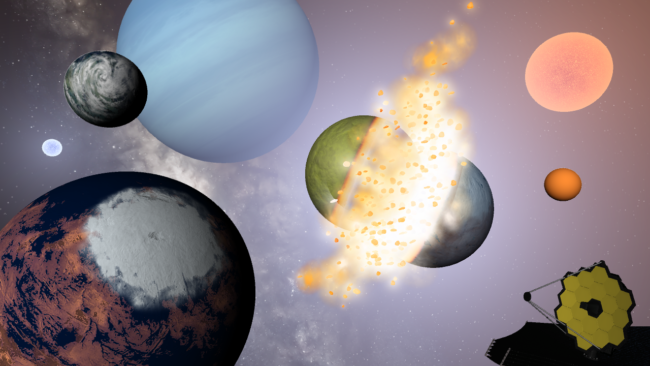
We’re constantly working to make Universe Sandbox even better, and we’ve only scratched the surface. Our plans this year include more materials, rigid body collisions, and more!
But first, what did we do in 2021?
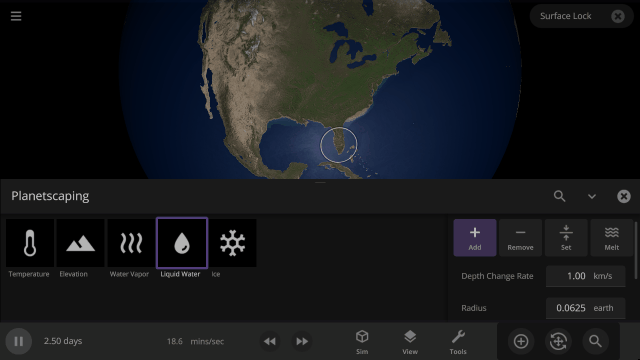
Over the course of 2021, we had 3 major updates and 5 minor updates.
- Splish, Splash, Filling a Bath | Update 26.3
- Oceans fill from lowest to highest elevations (like a bathtub)
- Fast & Flurrious | Update 27
- Snow simulation is more realistic for known and random rocky planets
- Temperature calculations are smoother at high sim speeds
- Clouds in Motion | Update 27.1
- Cloud speed is now simulated from an object’s temperature and rotational speed
- Atmospheric Adjustments | Update 27.2
- Atmosphere Opacity is now simulated (and customization)
- Codename: Fire Ring | Update 28
- Object collisions now have shockwave-based impacts
- Object trails project back in time and show their past trajectory
- My Eyes, the Space Goggles Do Nothing | Update 28.1
- Realistic Object Visibility better reflects what the human eye would see
- Starlite Starbrite | Update 28.2
- Stars now have Absolute and Apparent Magnitudes, which measure their brightness at different distances
- Starlight color on nearby objects updates in real-time
- Planetscaping | Update 29
- Manipulate object surfaces with the Planetscaping (Surface Editing) tool
- Collisions are more realistic with updated frictional forces
View our “What’s New” for a chronological list of changes.
And what have we already done in 2022?
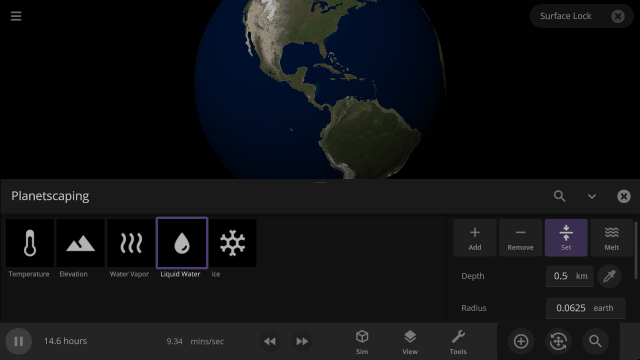
This year has already brought one major and one minor update, both focused on our collision-based goals for the year.
- Consistent Collisions, James Webb, & Planetscaping Tweaks | Update 29.1
- Fragments are now longer-lasting, and collisions are more consistent
- The Planetscaping tool now includes an eyedropper
- Hit Hard, Spin Fast | Update 30
- Spin planets apart at high rotational speeds with the new Force Spin tool
- Similar-size object collisions now symmetrically heat and fragment both objects
What’re we planning to do in 2022?
From simulation improvements to smoothing out our development process, we’re excited about what’s ahead. While we would like to do everything listed here this year, new priorities or unanticipated difficulties might arise and delay our plans.
Stellar Simulation
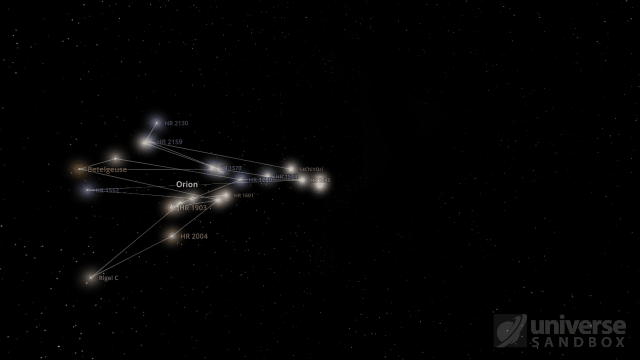
We’re planning to add new star-related features and are working to improve our star simulation.
- Constellations
- We want you to view and interact with Constellations dynamically. This is one of the oldest things on our to-do list.
- To simultaneously simulate the 691 stars for constellations, we’ve been improving performance for star glows, object labels, and more.
- Star Simulation
- Overhauling our current star simulation code to enable smooth star transitions as their properties change is a large task we’re actively working on.
- Revamped star simulation will lay the groundwork for improving stellar evolution.
Physics, Physics, Physics
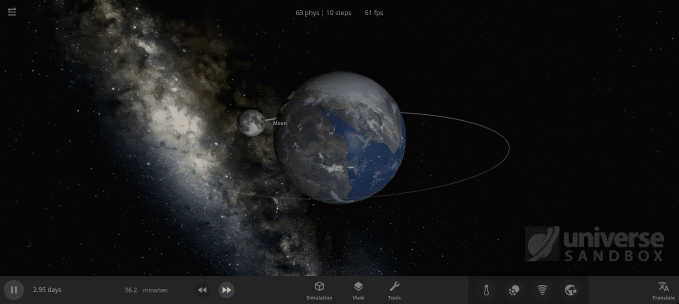
Collision and physics have been and continue to be a significant focus for us this year.
- Rigid Body Physics
- Anybody up for space-bowling? We’re continuing work to add new physics to allow better human-scale interactions (like bowling pins and satellites).
- This new system will serve as the foundation for spacecraft, thrusters, and megastructures in the future.
- Core Engine Rewrite
- As Unity continues to develop their new physics engine based on the Unity Data-Oriented Technology Stack (DOTS) framework, we’ve begun transitioning Universe Sandbox to this new system.
- This massive undertaking will eventually handle most computations in Universe Sandbox and will improve performance, particularly for physics simulation.
- Collisions: Physically Accurate & Overall More Awesome
- Allowing objects in collisions to deform fluidly will create more realistic collisions, including total disintegration.
- Previously we’ve looked into a method called Smoothed-particle hydrodynamics (SPH) for this simulation. However, due to some limitations of that method, we are now exploring other options more suitable for Universe Sandbox, like Positions Based Fluids (PBF) or Fluid-Implicit-Particle (FLIP).
- Rock fragments and gas clouds interacting and collecting more material over time will allow a more realistic planet or moon formation simulation.
- Allowing objects in collisions to deform fluidly will create more realistic collisions, including total disintegration.
Cross-Platform Support
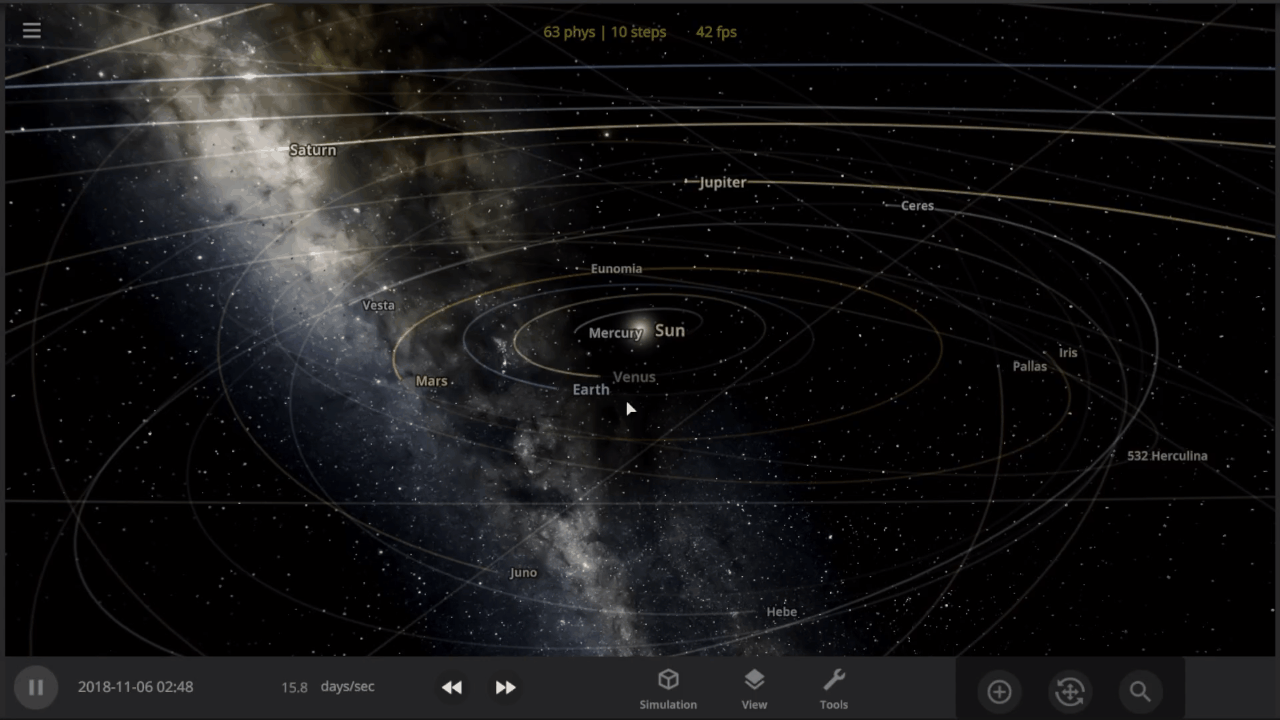
Our progress on the mobile version of Universe Sandbox (iOS and Android) was slower than expected last year, but we’re ramping it up this year.
- The Universe in Your Pocket
- Our two new user interface engineers will help us tackle the remaining challenges of mobile development, like window management on a small screen.
- Our goal is for the mobile version of Universe Sandbox to match the full desktop experience. Learn more in our Mobile DevLog.
- The Universe from Your Couch
- Want to play Universe Sandbox on your couch? Us too! We’ve begun experimenting with gamepad support for the desktop version, which is critical for future console development.
Materials & Beyond
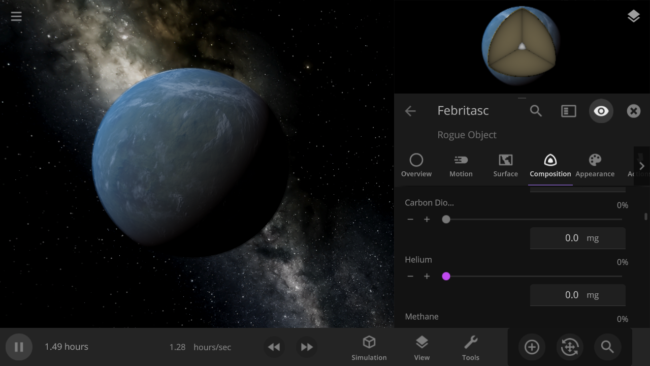
We want you to have access to more of the materials that make up our universe, like sulfur and oxygen, within Universe Sandbox. Adding more materials to our current system will allow better simulation of atmospheres, volatiles, and, eventually, life.
- Building with Basics
- Adding basic materials like methane, necessary for simulating the liquid lakes of methane on Titan, will be the first step for this material system.
- New materials will be included in surface simulation as we track their phase changes and movement across an object’s surface.
- Volatiles
- More materials will allow us to create a more realistic volatiles system, which determines both the composition of fragments and if an object is losing material.
Internal Automation & Testing
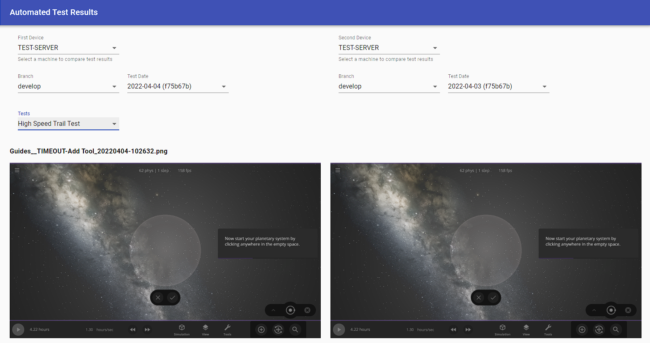
Part of developing Universe Sandbox (or any game) is identifying (and fixing!) bugs as early as possible. To help us with this, we’re creating new internal systems for our team to use to automate our deployment processes and test new and existing features.
- Build Automation
- An updated version, or build, of Universe Sandbox is automatically created every time we make a code change so we can easily playtest new changes.
- Developing tools to build and push new updates to Universe Sandbox automatically lets us get new features and fixes to you faster.
- Feature Testing
- We’re creating a suite of automated tests and setting up a system to compare their results so we can easily see simulation changes or issues.
- These tests can automatically click buttons, record GIFs, and more!
- We’re creating a suite of automated tests and setting up a system to compare their results so we can easily see simulation changes or issues.
Hiring
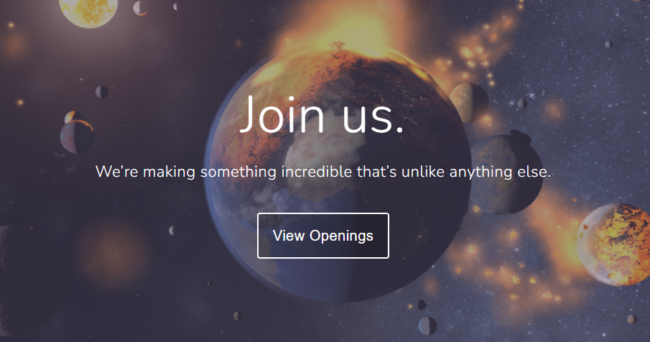
The key to creating a great game like Universe Sandbox is having a great team. Hiring the right people for the job takes time, but is always worthwhile.
- We’re Currently Hiring!
- If you know someone (or you’re someone) who you think would be great for our Cross-Platform Engineer or Spacecraft Physics Engineer positions, tell them to apply.
- If working on Universe Sandbox is your dream job, but we don’t have an open position for you, send us an email. We are always looking for help from the right candidates.
And More
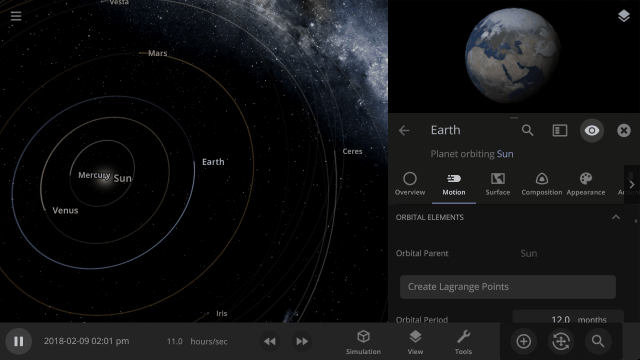
In addition to all of this, we have already
- Done some work to add Lagrange Points
- Started planning an expansion and overhaul of our in-game guide system
- Begun testing to allow access to even more planet customization options
We can’t wait to share this and more with you this year!

Universe Sandbox Roadmap: 2021.5 & Beyond
Jun 16th
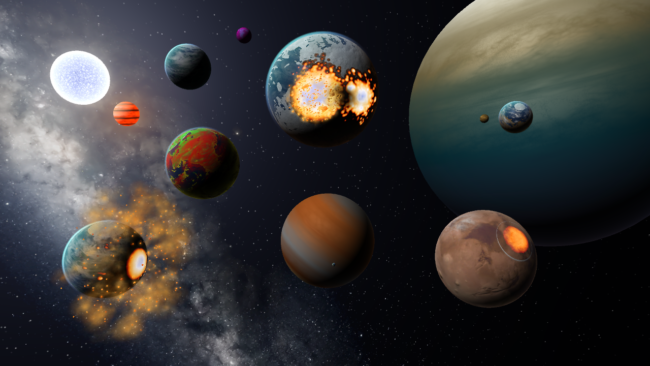
Last year we worked hard to make Universe Sandbox even better, and we’ve continued that work into this year with two updates already. We wanted to share some of the exciting plans we have for upcoming features including terrain manipulation, an expanded materials system, and more, that we have for the rest of the year (and a bit beyond).
What did we do in 2020?
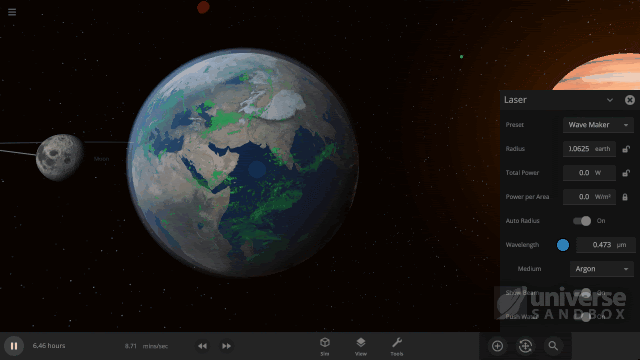
In 2020 we had two major updates and a few minor updates as well.
- I Like My Heat Tidal | Update 25
- Rewrote the tidal heating model and temperature calculations
- Major graphics performance improvements which allowed us to improve surface simulation
- Light It Up | Update 25.1
- Added randomizable city lights to all planets
- Improved how multiple light sources interact, particularly with atmospheres
- Even More Colors in Space | Update 25.2
- Even more custom color options for clouds, city lights, asteroids, and galaxies
- Improved energy calculations even more with laser, explosions, and impacts
- Reimagined Experience – Unified VR & Desktop | Update 26
- We brought the full desktop experience into VR
- Reimagined user interface with a customizable bottom bar
- Better looking collision fragments, rocky planets, and liquid water
- Star Fusion & the Brown Dwarves | Update 26.1
- Smoother simulated transitions between gas giant, brown dwarf, and full fledged star
- More customizable colors and laser improvements, including the “Wave Maker” laser
- Ending 2020 with a Bang | Update 26.2
- Objects retain lasting surface damage with craters and scorched areas
- More realistic explosions with better simulated gas particles
View our “What’s New” for a chronological list of changes.
What have we already done in 2021?
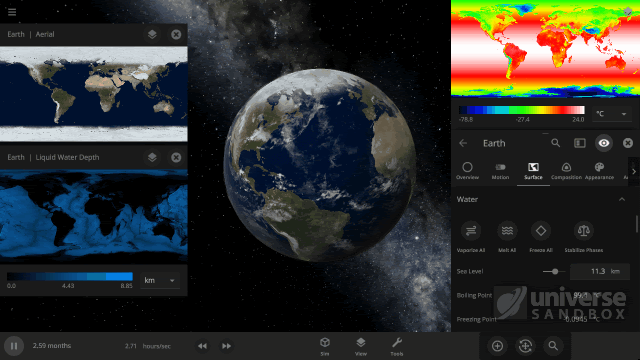
This year has already seen two notable updates that have included many fixes to our core simulation, a few new features, and improvements to the Universe Sandbox experience.
- Splish, Splash, Filling a Bath | Update 26.3
- Water fills from lowest points and flows to lowest points
- Smoother, better performing, and explodi-er collisions
- Fast & Flurrious | Update 27
- More realistic snow simulation and better looking random rocky planets
- Added a separate elevation adjusted surface temperature map
- New Render Scale settings to improve performance for non-gaming hardware
New team members
Brent was hired in March as our new Science Writer & Community Advocate. Brent has a PhD in Physics and will be writing about all of the awesome science and simulations that Universe Sandbox can do (including writing this post – Hi Everybody 
We also recently hired Brian as our new User Interface Engineer. Brian joins us after working as a frontend web engineer, and is excited to help make Universe Sandbox the best possible experience for exploring space and science. He’ll be implementing some of the many, many user interface designs we’ve been working on.
What’re we currently working on?
You’ve seen some of what we’ve been up to this year from the updates we’ve put out already, but there’s still a lot of new features in development. While we would love to get all of these new features and improvements out by the end of the year, there may be new priorities or unexpected difficulties that pop up, which make it hard to predict exactly when we will have these features ready.
Surface Grids & Planet Appearances
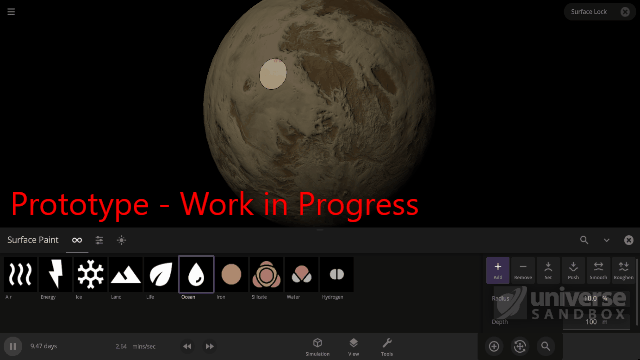
The simulation of temperature, ice, water, vapor, and other properties across the surface of an object, a feature we call Surface Grids, has become a fundamental part of Universe Sandbox. Read more about Surface Grids in our DevLog and ScienceLog series. Yet even with all of the improvements we made to them last year, there is still so much that can be done.
- Planet Surface Editing
- Last year we did a bit of work designing and determining the best way to add tools that will allow you to directly edit the surface properties of an object, and we’re hoping to implement those tools this year.
- You’ll be able to change your planet’s elevation, water level, temperature, and more with single point precision on the surface grid.
- Improved Atmosphere Simulation
- With many improvements in performance in Update 26.3, we are looking into extending the atmosphere of planets into the surface grids simulation.
- Better simulated atmospheres will allow for more realistic climate and cloud simulation.
- Fiery Collisions
- We plan to build upon the collision improvements introduced in Update 26.3 with more realistic post-impact shockwaves, fragmentation, and grazing impacts.
Enhanced User Interface
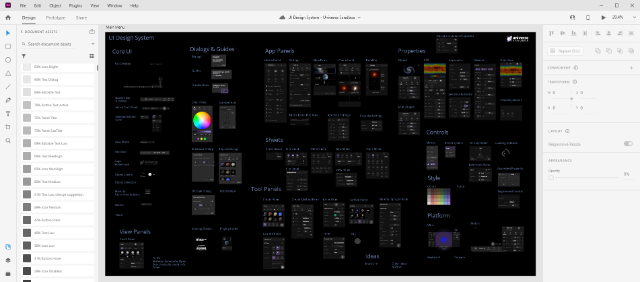
Our goal for each update to Universe Sandbox is to improve your experience. This might involve updating our user interface, improving our guides for new users, increasing performance, and other small tweaks.
- Towards a Forward-Thinking User Interface
- We’ve taken a responsive design approach that lets the interface work universality across desktop, mobile, VR, and future-gamepad support in mind.
- We already redesigned the Add panel in Update 27 and unified the styling in preparation for future tools and features, like the surface enhancement tools we mentioned above.
- The Most Enjoyable Experience
- In addition to guide rails, which help walk users through our tutorials, that were added in Update 27, we want to update and add more guides and science simulations for new and old users alike.
…and Beyond?
In addition to all of these plans, we also have some longer-term goals, and though many of these may not happen for a while, we wanted to share with you.
Multiple & Mixed Materials
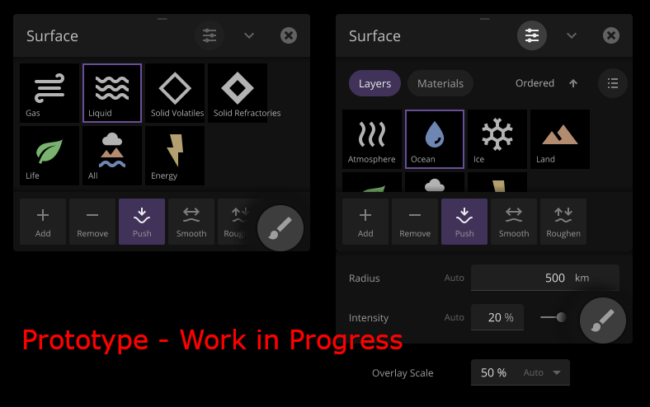
We want to give you access to more basic materials, like methane, CO2 (carbon dioxide) and O2 (oxygen), to our current system. Not only will a more robust material system allow you to further customize your planets, moons, and asteroids, but it will also make future features, like Life Simulation and realistic atmosphere simulation, possible.
- A Material World
- More materials will allow for more planet customization and allow more versatility in terraforming planets. They will also allow you to customize your planet’s atmosphere — will it be suitable for life, or mostly composed of methane like Titan?
- Multiple materials will be critical for developing life simulation in the future. Life is made up of complex materials after all.
- Unified Materials System
- Our goal is to track all the different materials, and the state that they’re in, in each point in a surface grid on planet surfaces.
- Keeping track of all of these materials and their properties will allow for more realistic simulation calculations in general, like the phase state (solid, liquid, gas) changes for all of our new materials.
Rigid Body Physics
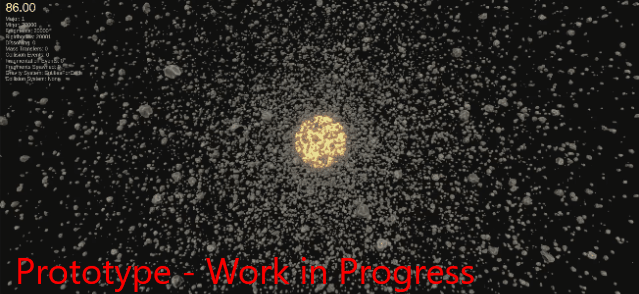
Currently our physics engine isn’t optimized for rigid body physics required for proper human scale (like dice and spacecraft) object interactions. We’re working to change that and have been researching different methods of implementing a whole new suite of physics into Universe Sandbox.
- DOTS-based Unity Physics
- Unity has introduced a promising new physics engine that we’ve been spending time researching. Based on the Unity DOTS (Data Oriented Technology Stack) framework, the new Unity Physics engine promises significantly better performance.
- This DOTS-based Unity Physics would not only enhance our rigid body physics, but would also be used to improve the performance of our gravity simulation.
- To Infinity and Beyond
- Much like Surface Grids, rigid body physics lays the foundation for many simulation features to come, such as spacecraft, thrusters, and megastructures.
- Having more bodies that follow these new physics will also allow you to better simulate how larger bodies form as smaller objects clump together. Make planets out of asteroids, or pigeons, it’s up to you.
Mobile
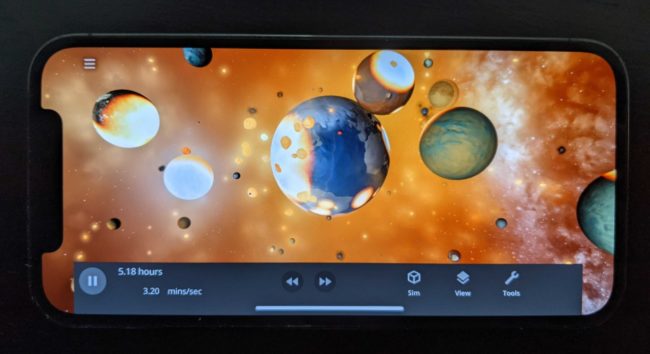
We’re still actively working on a mobile release for both iOS and Android, though there’s still many design questions to be answered.
- The Full Experience on Mobile
- When we bring Universe Sandbox to mobile, we plan to bring the full desktop version to mobile so you’ll have access to all the same features, just in your pocket!
- A smaller screen means our user interface will need to be even more innovative, and we’re working hard to make sure that the mobile experience is just as fun to play as it is on a desktop.
And More
There’s no shortage of additions and improvements to be made when you’re simulating the Universe! We’re also thinking about future features like Lagrange points, atmospheric scattering, and life simulation, and we’re excited to share them all with you!
Hiring
We’re currently hiring another Physics Engineer, join us!
Answering Some of Your Questions (Addendum)
We’re really glad that you all enjoyed reading our Roadmap. You asked a lot of good questions and we wanted to answer some of them here:
1. Will you be able to export (and import) height maps for celestial objects?
We plan to support importing and exporting of surface maps, but we don’t yet know when that will happen.
Much of the surface data (like elevation and color) that we use for known solar system objects is based on data available online. You can find similar maps to the ones we use online, like this set of Moon elevation and color maps (though these are not exactly what we use).
2. What materials are you planning on adding?
Development of adding additional materials to the simulation is still in flux. Our goal is to add all the basic materials that are necessary for simulating basic life like carbon dioxide and oxygen, as well as some others like methane and sulfur, which are found in large quantities on other planets and moons in the solar system.
3. Will we be able to make planets out of any materials?
Great question. When we add additional materials to Universe Sandbox, we are planning to make them available as part of an object’s Composition properties, similar to our current system, so you’ll be able to make planets out of any material we add.
4. Will we be able to make megastructures like Death Stars?
We think this would be really fun, and actually have this on our Roadmap already. The general idea would involve a separate system to build megastructures like Dyson Spheres (or even Death Stars). However we still have a lot to do before we start work on that.
5. Are we adding sentient life as part of our life simulation?
That is a cool idea. We’re still a ways away from even the simple life simulation we are hoping to implement though. The first version of life simulation will likely be a surface map, similar to our other surface grid maps, that would show “amount of biomass” or “vegetation,” but we don’t have all of the details worked out yet.
6. Any plans to make the game run in Vulkan?
While we don’t have any plans right now to support Universe Sandbox for Vulcan, an API for graphics rendering and computing (different from what we currently use), on Desktop, that doesn’t mean we won’t look into it in the future.
7. Will we be adding continental drift or volcanoes?
Right now we don’t have any plans to add either of these features, though we have thought about adding very simple volcanoes in the past. There are a lot of improvements and fixes we need to make to the core features before we think about adding in complicated features like that.
8. Is there a way to beta test new features?
Yes! We will occasionally release Community Test builds to get feedback on new features and help us find bugs. We announce when these go live in a post on the Steam Forums and on our Discord server.
9. What devices will Universe Sandbox mobile be available on and will it be free for those who have already bought Universe Sandbox?
Universe Sandbox will be available on both iOS and Android devices. Minimum device requirements have not been finalized yet.
We still do not have a release date or official price for mobile, but we do plan on it being a one-time paid app with no ads or in-app purchases. The desktop and the mobile versions will be sold on separate stores and will be separate purchases. If you want Universe Sandbox on your mobile device you will need to purchase from the mobile store, even if you already own Universe Sandbox on desktop.
10. Are we still working on Smoothed-particle Hydrodynamics (SPH)?
We have shifted our focus on fixing problems and bugs with the fundamental systems and simulation before resuming work on awesome new features like SPH. That said, we still want to do SPH, but are actively working on improvements to the current collision system that we discussed in the Roadmap.
Learn more about SPH in our SPH blog post.
Updated July, 15, 2021

Universe Sandbox Roadmap: 2020 & Beyond
Apr 30th
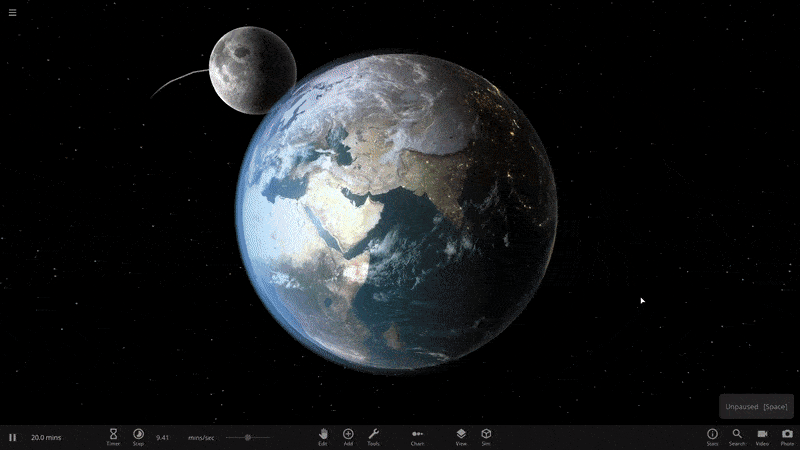
Universe Sandbox has improved significantly since our first Early Access release in 2015. We plan to add features and fix bugs for a long, long time to come (we even removed the “2” from our name for that reason). Here’s a look into what we have planned for 2020 and beyond.
What did we do in 2019?

Last year saw 3 major feature releases (and a handful of minor, but still important, updates):
- Better Galaxies (Update 23)
- More stable and accurate galaxies and better collisions
- New and improved Introduction tutorial for helping new users
- Surface Grids & Lasers (Update 24)
- Surface Grids is a huge, complex feature that simulates the surfaces of planets, moons, and other objects
- Vaporize entire planets with the new Laser tool
- Custom Object Colors (Update 24.1)
- Customize colors for just about every object including planets, moons, stars, and black holes
- Dock graph windows alongside the other panels added with Surface Grids
View our “What’s New” for a chronological list of changes.
What’s the Plan for 2020?
The following list are all things we are working on currently. We’re aiming to deliver on all of this in 2020, but when they’ll be ready is difficult to predict, and priorities can change.
With its ability to simulate localized surface temperatures, water level, vapor content, and more, Surface Grids (Update 24) perfectly sets us up for a multitude of new features. Localized temperatures enabled us to create the mighty Galactic Empire Superlaser, but that’s only scratching the surface…
Surface Grids Improvements

We’ve been saying that Surface Grids is the foundation for many things to come, so it only makes sense that we start the year off by further improving it.
- Improved Temperature & Atmosphere Simulation
- Surface Grids improvements started this year in January (Update 24.1.2), continued with Update 25 (March 2020), and will be a theme all year long
- Update 25 introduced a major rewrite to Tidal Heating and Vapor Flow calculations
- Better Performance & More Power
- Not only have we accomplished localized surface simulations on your everyday computer, but we continue to make performance improvements
- Shader Model 5.0, a graphics card technology, became a requirement in Update 25 because it will give us some legroom for current and future enhancements
- Detailed Surface Manipulation
- We are in the early stages of designing tools that allow for directly manipulating temperature, elevation, water level, vapor, and more on the surfaces of objects
- We plan to add the ability to view and edit the properties of individual surface grid “cells”. Take your planet customization and terraforming to a new heights with a level of precision you never thought possible
Material Composition System
Building off of the localized materials (water, CO2) in Surface Grids, we’re working to rebuild our material composition in a more robust way.
- Better System to Unify Materials
- Every point on the “grid” will better contain a mixture of various materials, in various material states
- Complicated calculations of, for example, when some liquids become heated to a gas, should be handled more efficiently in our new simulation code
- A Universe of Possibility
- Better terraforming, more realistic cloud and climate simulations, tidal waves, easy ways to manipulate the surface topography, and more detail on the surface view could all be the results of this new Material Composition System
- Who knows, maybe our planets could one-day support life?
Full Desktop User Experience in VR
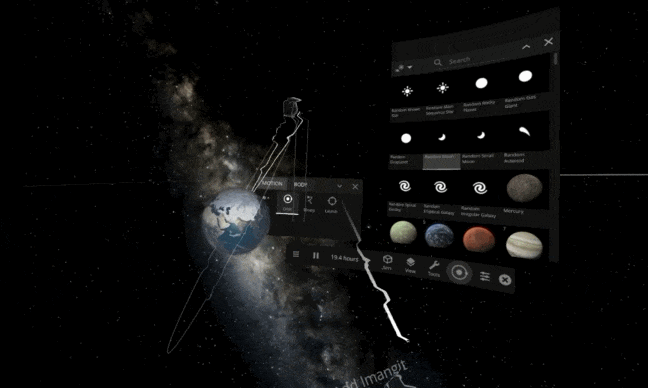
We have embraced a seemingly impossible goal of having a unified Universe Sandbox release no matter how you play. Whether you are on a powerful gaming PC, a laptop, a phone (coming soon), Virtual Reality, Mixed Reality, or a console (maybe soon? who knows!) the experience should be undiluted and awe-inspiring.
- A Magic Leap Forward
- With our recent Magic Leap 1 release, we were able to bring the full Desktop experience to the world of Mixed Reality
- Hard work pays off: the bulk of our Magic Leap 1 development helped unify our Mixed Reality, VR, and Desktop experience into one single vision
- Get Your Hands on it
- Enjoy Universe Sandbox in VR without limitations and with the full Desktop User Interface
- Grab planets with your hands, shoot lasers out of your fingertips, and watch galaxies collide as if you were really there, floating in space (but a bit less cold).
User Interface Improvements
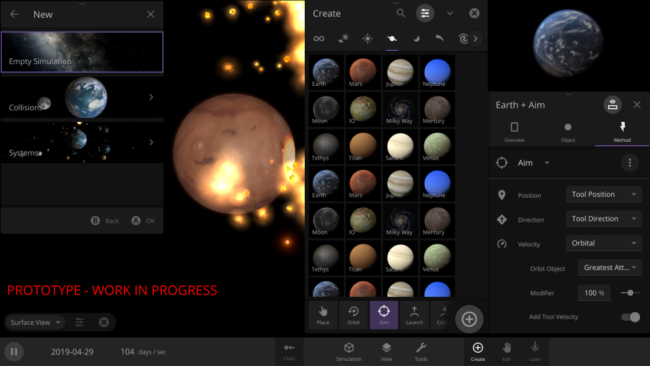
Creating the user interface (UI) for Universe Sandbox is a fun challenge. How do you give someone full control of the universe? As we add features and complexity to the simulation, keeping the UI accessible, discoverable, and easy to use becomes a constant challenge.
Over time, some portions of the interface can start to feel cluttered or outdated and are ready for a redesign. We’ve been working on some of these design changes for a long time, and it’s exciting to move closer to improving everyone’s experience with Universe Sandbox.
- Redesigned Bottom Bar
- Our current bottom bar has been collecting new buttons over the years without a cohesive vision for how it should all work. So we’ve rethought how everything should be organized and how we can make it work on really small screens.
- Improved Add Panel
- Like the Bottom Bar, the Add Panel is due for a makeover. We’re targeting a single shared UI for all platforms (desktop, touch, VR/AR, and consoles), so the new Add Panel is being built with that in mind.
…and beyond?
Mobile
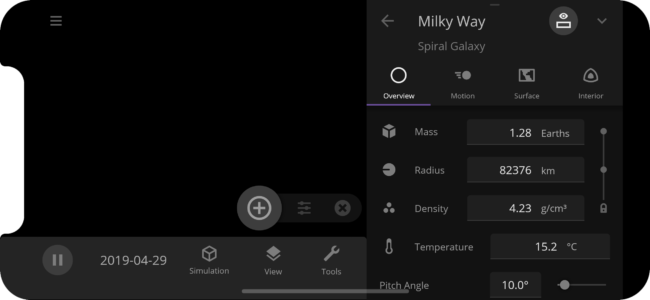
Enjoy Universe Sandbox on your phone or tablet! Sign up to get notified about our mobile version.
- Is that Universe Sandbox in Your Pocket?
- Our mobile version is in development right now for both Android and iOS. It’s no easy feat to simulate the universe on a smartphone, but we’re doing it!
- A Pure, Unadulterated Experience
- Some of the breakthroughs we made with both Surface Grids and Magic Leap have paid off and will allow for the full desktop version on your pocket-sized device
Life Simulation
Create the right conditions for life and watch it grow, or end it all with a major impact.
- Turn a cold, lifeless space rock into a vibrant planet
- Many details are still TBD, keep an eye out for a DevLog when we get started
Fluid Simulation

Smoothed-particle Hydrodynamics (SPH) will help create more detailed, realistic simulations of collisions, fragmentation, and formation of different types of objects. Read more in our SPH Fluid Simulation DevLog.
Experiments with Tools

This is firmly in the realm of experimentation at the moment, but we’re looking at new and interesting ways we can use our tools within a simulation. Driven by a need to automate testing of features, we’re working on ways to programmatically activate tools. By automating and attaching different tools to objects, we discovered that we can enable some pretty fun scenarios. The above clip is what happens when we attached a bunch of lasers to moons and tell it to automatically fire at the nearest object. Awesome stuff, right?
Gamepad Support… and more?
Do you want to sit back on your couch and play Universe Sandbox? So do we! We’ll be experimenting with full gamepad support. Who knows where that leads us, maybe even a console version in the future.
Hiring
We are currently hiring a Spaceship Physics Developer, join us!
Universe Sandbox ² Updated 2017 Roadmap
Aug 28th
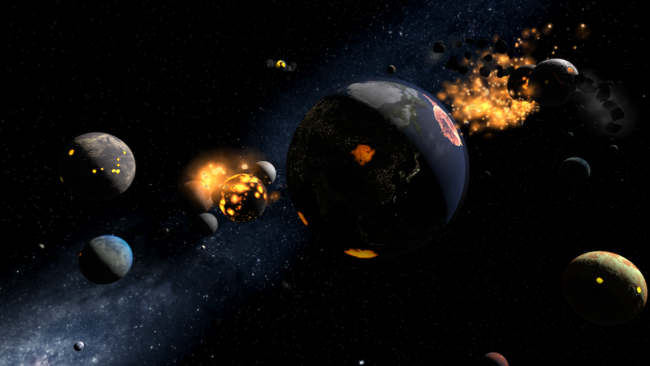
What’s Completed
At the beginning of this year, we shared Part I and Part II of our roadmap for 2017. We’ve now well past the halfway point, so it’s time for an update on what we’ve accomplished so far and we’ve got our sights set on for the rest of 2017 and into next year.
A New Foundation & VR 2.0 | Update 20
This was a big update for us, with a lot of important behind-the-scenes changes and a big list of VR improvements. Below are some of the highlights from this update; check out the Update 20 post for more information on how it’s paving the way for some bigger changes down the road.
- Rewritten, Scalable User Interface
- With our rewritten user interface, you can now scale the interface for smaller and larger resolutions.
- Future support for on-the-fly switching between multiple languages (see below).
- New Code Architecture
- A major reorganization that will make it easier for us to maintain our code, track down bugs, and develop and iterate on features.
- VR added Disintegration, Teleportation, and a Lot More
- Added all the new simulation features, improvements, and fixes from the Disintegration desktop updates, including…
- Tidal forces
- Improved explosions, and…
- New fragment and particle system
- A completely rewritten locomotion system for more responsive and smoother panning, scaling, and the all new rotation
- Teleportation! It’s never been easier to move from one planet to another
- Added all the new simulation features, improvements, and fixes from the Disintegration desktop updates, including…
Update 20 also included a long list of smaller improvements and bug fixes. And in the past couple of months since its release, we’ve pushed out smaller patches with many more bug fixes, plus the eclipse update below.
Solar Eclipse | Update 20.1
You probably heard about the August 21 solar eclipse that was visible from all of North America. We hope you were able to see it in person! But if you weren’t able to, or if you just want to see it over and over again now, then we’ve got just the simulation for you. See the Update 20.1 blog post for more info.
- August 21, 2017 Total Solar Eclipse Simulation
- Home > Open > Total Solar Eclipse on August 21, 2017
- A simulation of the Moon passing between the Sun and Earth and blocking out light across North America.
- Shadow Improvements
- Using past eclipse images as a guide, we’ve tweaked shadows just a bit to better capture Moon’s shadow on Earth.
- Advance Time Feature
- Introduced in 20.1.1, this feature allows you to run the sim until a specified length of time has passed. Just click the timer in the bottom bar to set a date or length of time then click Start!
What’s Coming Next
The following list is in a very rough order. These are all things we are working on currently, but when they’ll arrive is difficult to predict. If we had to guess when we’ll first start seeing them, we’d have to simply say “soon.”
Planet Grids
A debugging tool we are using to test the new planet grids. This tool shows how temperature is broken down into data points across the surface of the planet.
Planet Grids (previously called “automata”) is a new piece of tech that we’ve been working on for a while now that we’re very excited to introduce. The first stage of this tech allows us to simulate localized temperatures across surfaces, rather than an average temperature for the whole object. In turn, this will allow for much more dynamic and detailed visuals and simulation. This is also a crucial first step for another feature that’s long been coming…
Lasers
Lasers are fun for everyone! We’re very excited about introducing these, but it’s possible the community is even more excited. We don’t blame you. Good news: the laser is coming soon to the desktop version and will simultaneously return to VR with improved realism and functionality.
- From Laser Pointer to Planet Destroyer
- Set the power of the laser to go from a realistically-powered laser pointer to a laser far more powerful than anything ever produced, one capable of melting all of the ice off of Earth and heating it up to the point of complete vaporization.
Stellar Evolution
We unfortunately had to push this out of the Update 20 release because it simply took longer than expected and was not finished. The model itself is complete, but removing the old model and replacing it with the new is no simple task. Once we’ve got it plugged in, we’ll need to thoroughly test it to make sure that everything is in good shape and working as expected. This also is no simple task (there are many variables when it comes to testing stellar evolution in a universe simulator), but we’re definitely nearing completion.
- A Rewritten Model for the Life of a Star
- The new model supports 16 evolutionary star types versus the previous 5. It is primarily a function of mass and age or metallicity, and will work for evolutionary types outside of main-sequence stars.
- The results will be more dynamic and accurate properties for stars, as well as smoother transitions from type to type. It will also support mass loss from solar winds, and be able to differentiate envelope from core.
Steam Workshop
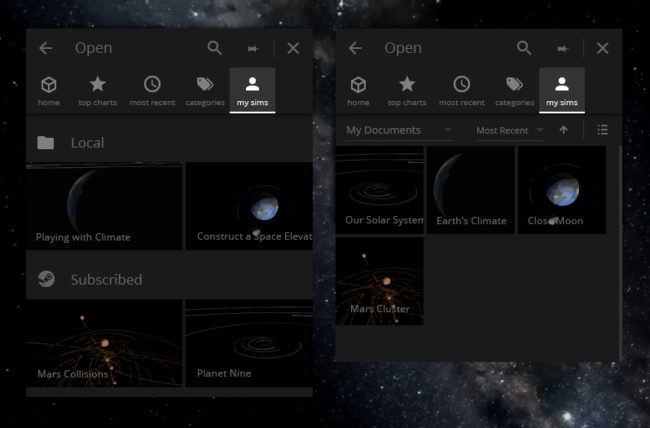
Early design mock-up of a new interface for with support for Steam Workshop simulations.
We’ve just begun work on adding Steam Workshop support to Universe Sandbox ². There’s plenty to do on the design front, and we have kinks to work out with our save & load system, but all things considered, we’re making good progress. Steam Workshop support is often requested by the community, and for good reason — we’re very excited to see what happens once it becomes easy to explore all of the simulations and scenarios the community is creating… and destroying.
- Share Simulations & Objects with the Whole Community
- Space may be a vacuum, but that doesn’t mean you should feel like you’re living in one in Universe Sandbox ². With support for Steam Workshop, you can easily browse, vote on, download, and explore community-created sims and objects, and of course upload your own for the whole community to check out.
- And Eventually, Share Models & Textures Too
- The first iteration will likely only support custom sims and saved objects, but in the future (see below) we plan to add support for custom models and textures as well.
Faster Physics & Performance
Thomas, our physics programmer, has made substantial upgrades to the physics code more times than we can count. But whatever number that is, add one more. We’re extremely grateful for every improvement, as physics is at the core of Universe Sandbox ², and making it faster means a lot more than just simply adding on a few FPS.
- Rewritten Physics Code
- A smoother user experience, more stable simulations at higher time steps, and more room for all of the big, new physics features we’re working toward, such as rigid body collisions, total body fragmentation, and space megastructures.
And Then Into 2018…
Localization
- Supported by New User Interface
- Now that our new user interface is in Universe Sandbox (Update 20), we’re ready to add the localization system.
- Community-Sourced Translations
- We plan to ask you, the community, for help in translating all of the text in Universe Sandbox ². We’re not certain how it will work yet, but our ideal system will let you click on any snippet of text from within Universe Sandbox ² and offer a translation or an improvement on an existing translation.
- Switch On-the-Fly Between Multiple Languages
- You’ll be able to switch at any moment between available translations. What is available depends on the community — as long as one user has offered translations, then it will be available for everyone to use and improve upon.
Custom Models
- Import Models & Textures Created by You or the Community
- This is in some ways the second big part of the Steam Workshop support. Being able to browse and download community-made models and textures which you can use in Universe Sandbox ² is going to help a lot with all of the requests we get for fictional and real spacecraft and planets. Of course, custom models means you can import whatever model you like (limited by file type), so if you’d prefer a cow over a rocket ship, then that’s okay too.
Rigid Body Collisions
- Bouncing and Breaking Apart Human Sized Objects
- Right now, human sized objects in Universe Sandbox ², like dice or bowling balls, will combine when they collide. Rigid body physics will make these collisions much more realistic, so they’ll instead “bounce” off of each other as you would expect them to.
- And Don’t Forget Stacking and Connecting
- Bouncing only makes sense some of the time for rigid body collisions. If you’re on the surface of a planet, for example, then you should also be able to stack these objects. Where does connecting come into this? Well, if you have rocket parts, then those should probably snap together… But we’re still far away from this.
Total Body Fragmentation
- Kaboom!
- With this new system, bodies will completely fragment when the force of a collision is strong enough. This should be most apparent when two equally sized bodies collide, as they should completely fragment apart instead of one “eating” the other, which currently happens.
More Advanced Planet Grids
- More Detailed and Responsive Planet Visuals & Interactions
- The first iteration of Planet Grids which is arriving along with lasers will help with temperature, but eventually the system will become more complex and allow for more advanced simulation, such as freeze heights, improved molten visualization, and…
- ???
- It’s hard to say what Planet Grids has in store for us next. Heat transfer between planetary layers? Life simulation? Maybe! We don’t have an exact plan, but we’re excited by all of the possibilities that open up with Planet Grids.
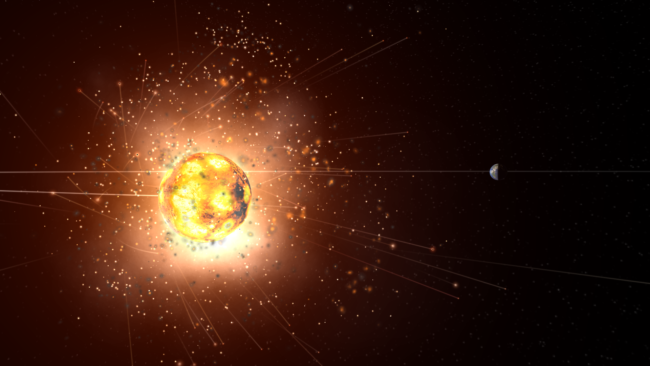
And Into the Distant Future
Mobile Version
- Universe Sandbox ² on Your Phone and Tablet
- Universe Sandbox ² is all about asking fantastical what-if questions. Well, what if you could simulate the universe on your phone? Our guess is you’d probably be pretty happy. At least, that’s what’s been proven true so far whenever we run a test build on our mobile devices. There are many user interface challenges still to solve, but we’re making good progress on this mobile version.
Space Megastructures
- Megastructures, But in Space
- We mention these a lot, even though they’re not on the immediate horizon, because they’re just that exciting to think about. Using physics-based space tethers as the idea behind the basic building block, these structures can come in many pre-defined shapes and sizes, and eventually support building custom structures.
- Think space elevators, Dyson spheres, and ring worlds. And then squeal with joy (and patience).
There isn’t a single item on this list that doesn’t get us excited. We’re happy with how far we’ve already come with Universe Sandbox ², and now we’re itching to see where these new features take us and our fans. There will soon be even more tools for creating and exploring whatever you can imagine, and you’ll have the ability to share these with the entire community, a community that will expand with localization and the mobile version. Many thanks to our ever-growing community of fans for all of your support.
For the latest Universe Sandbox ² news, follow us on Twitter and Facebook.
Universe Sandbox ² 2017 Roadmap | Part II
Feb 27th
What’s Coming After Alpha 20?
In Part I of our 2017 Roadmap, we talked about what we accomplished in 2016 and about our next stop, Alpha 20. We hope to release Alpha 20 in the next few months, and we’re very excited to introduce the new stellar evolution, the reworked user interface, the analytics, and a few other changes. And then it’s time to set our sights forward again to all that lies beyond Alpha 20.
VR Update
Our new, dedicated VR developer, Jacob, has made good progress getting up to speed on our project and is already cranking out fixes and improvements for our VR experience. It’s been a while since we’ve been able to update the VR version, but we’re excited to bring it up to par again with the desktop version and introduce a few changes to the controls, interface, and introductory experience. If we’re lucky, this VR update may be paired with the Alpha 20 desktop update, but no promises.
Here’s what will hopefully be in our next VR update:
- Updated to Alpha 19
- Alpha 19 added some big simulation features which are currently missing in the VR version, like tidal forces, reworked explosions, new volatile effects like vaporized planets, more variety in supernovae, and greatly improved appearance and performance for particles and fragments. Alpha 19 was a huge update, and we’re excited to bring that to VR users.
- New tutorials
- One piece of feedback we see the most on our VR mode is that there’s not enough guidance, and the controls can be a little unwieldy. We’ve had some bigger ideas about redesigning the controls and interface, but these changes will be a longer project for another day. Until then, we’ve been tightening up the current controls, tweaking the interface, and adding some introductory experiences, all of which should help a lot in orienting new users and making for a smoother and more intuitive experience.
- Official Oculus Touch support
- Technically, anyone with an Oculus Rift and the Touch controllers can already play Universe Sandbox ² VR without any issue, the only noticeable difference is that the in-game controller models are Vive controllers instead of Touch. But this update will address this difference and add a few other small compatibility changes in order to officially support Touch. We also plan on adding Universe Sandbox ² VR to the official Oculus Store.
Then after this update, we’ll be looking at bigger design changes, like adding more interactive tools and accompanying custom controller models, to make the VR experience even more impressive and compelling. Below is a screenshot of some concept art for what a planet gun might look like in VR, designed by Nikita Replyanski. Please note that this is very early concept art and does not necessarily reflect what will be in Universe Sandbox ².
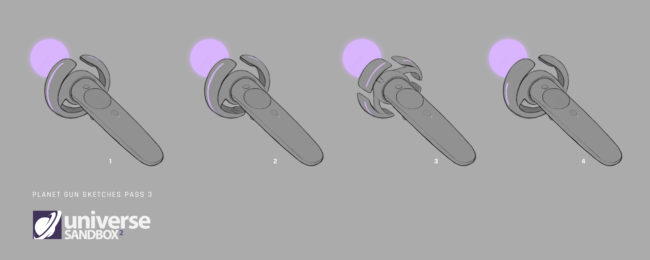
Alpha 21 & Beyond
This is where our list of future improvements and features becomes a little less concerned with order and time. We can’t say with much certainty which will be arriving first, or which will be bundled in this update or that update. But we can say with a lot of certainty that we’re very excited for all of these changes, and we believe each will add a new element to the Universe Sandbox ² experience. Many of these are big projects, but as mentioned in Part I of our roadmap, we hope to keep these projects less intertwined than in the past. This will hopefully allow us to roll out these changes as they’re individually ready and stick to a more frequent and regular release schedule. Please note that none of the following are guaranteed to happen in 2017, but we should see a number of them this year.
More Likely to Arrive First
- New Native (Better, Faster, Stronger Physics)
- Thomas, our lead physics developer, is once again revamping the physics system in Universe Sandbox ². You can expect better overall performance, faster simulations, and greater accuracy.
- Second Stage of Planetary Grids/Detail/Automata
- As mentioned in Part I, this isn’t a single feature, but rather a system that will open up the doors for a bunch of features that will make planets visually more detailed and responsive to interactions. The first stage was simply some movement behind the scenes, but this second stage will introduce some visible changes for users.
- This system works by increasing the spatial resolution of data. Instead of having one point of data for an object’s property, like temperature, there will now be a 2D grid of data. With temperature, for example, this means that collisions can impact values locally, so heat spreads from the impact site rather than just raising the overall temperature. This can also help with more accurate volatiles, tidal heating, tidal locking, and can also factor in elevation.
- New Sound Effects!
- We’re now working with the sound design team, A Shell in the Pit (whose credits include work on Fantastic Contraption, Parkitect, and many other great titles) to produce brand new sound effects for Universe Sandbox ². First on the list will likely be collision sound effects and user interface sounds. It’s quite the design challenge, as they’ll have to account for things like changes in the time step and sounds for which there is no real-world equivalent… what exactly should a pulsar sound like?
- Galaxies
- We know that galaxies in Universe Sandbox ² could use some love, and we plan to give them the love they deserve soon. Their overall appearance will get an overhaul, and they’ll no longer resemble jumbled, generic galaxies.
A pulsar in Universe Sandbox ².
More Likely to Arrive Later
- Total Body Fragmentation
- Pretty self-explanatory: with this new system, bodies will completely fragment when the force of a collision is strong enough. This should be most apparent when two equally sized bodies collide, as they should completely fragment apart instead of one “eating” the other, which currently happens. Our physics developer will begin work on this again after finishing the New Native described above.
- Third Stage of Planetary Grids/Detail/Automata
- Heat transfer between planetary layers? Life simulation? Maybe! We don’t have an exact plan for where this system will take us after stage two, but we’re excited to find out.
- Mobile Version
- Sure it’s cool playing Universe Sandbox ² at your desk, but what if you could simulate the universe on your phone that you just pulled out of your pocket? And then with a tap of your finger you send a black hole careening past the sun, putting our whole solar system in galactic jeopardy? All while waiting for the bus to arrive? Yeah that sounds pretty cool, too. And with the processing power of modern phones and tablets, it’s not as far-fetched as you may think. In fact, we already have a version up and running on some of our phones. There’s still a lot of work to do on optimizing for performance and controls, but we’re making good progress.
- Steam Workshop & Custom Models
- Sharing is caring. Of course, your carefully crafted custom solar system still exists even if you’re the only one looking at it, but wouldn’t it be more fun to share it with thousands of other Universe Sandbox ² fans? You can already manually share these files, but we want to support seamless sharing and browsing of custom simulations and bodies using Steam Workshop. Combine this with support for importing your own models and suddenly you have access to whatever planets, stars, and spaceships our passionate and talented community dreams of.
- Rigid Body Collision System
- If you’ve ever collided a bowling ball with some dice in Universe Sandbox ², you know that they just merge with each other, and if you’ve ever seen these collide in real life, you know that’s not entirely realistic behavior. That’s why our new physics developer, Rahul, is working on the solution to this exact problem. Then it’s onto other areas of rigid body physics, like constraints, stacking, and collapse, which paves the way for space megastructures and even pilotable spaceships.
- Constellations
- Universe Sandbox ² isn’t designed as planetarium software, but we agree that being able to view constellations can be fun and educational, especially when paired with a sandbox environment. It’s an often requested feature that hasn’t made its way over yet from Universe Sandbox Legacy, but we plan to devote some time to this for a future update.
- Atmospheric Scattering
- Sunrises and sunsets are universally loved, whether your planet orbits one star or five. Wouldn’t it be great to see them in Universe Sandbox ² when standing on the surface of your planet? This is where something called atmospheric scattering comes in. We teased this a long time ago with a demo video, but it only existed as a project separate from Universe Sandbox ². We still plan to implement this eventually, as it certainly adds a small but dramatic touch to the surface view.
Jupiter orbiting Wolf 359 in Universe Sandbox ².
And Then Even Later…
- Spaceships
- Yes, we mentioned “pilotable spaceships” above, but remember that rigid body physics are only a step toward these and they are still a long way off. Doesn’t mean we’re not completely in love with the idea and already looking forward to the possibility!
- Space Mega Structures
- Using physics-based space tethers as the idea behind the basic building block, these structures can come in many pre-defined shapes and sizes, and eventually support custom building. Think space elevators, Dyson spheres, and ring worlds. Then just attach a ridiculously overpowered laser, and you’ve got yourself a DIY Death Star. There’s still a lot to do to get these running smoothly in a simulation, but the above-mentioned work on rigid body physics will help us get there.
- Procedurally Generated Planetary Surfaces
- Users often tell us they want to see more details when entering surface cam (select a body and press “C” to enter surface cam). Once implemented, this will be a great answer to that request. Instead of relying on a small number of hand-crafted textures, planetary surfaces could instead be procedurally, randomly generated, resulting in an endless variety of surfaces with a dynamic range of detail. This is just in the idea phase right now; we have not begun work on it yet, and it won’t be a quick project. But we know that it could add another level of immersion and realism to Universe Sandbox ² and be a fan-favorite.
Excited? As we’ve said many times, so are we. Thank you for your never-ending support, and thank you for your patience as we continue to build the universe.
For the latest Universe Sandbox ² news, follow us on Twitter and Facebook.
Universe Sandbox ² 2017 Roadmap | Part I
Feb 15th

Set the background in Universe Sandbox ² by clicking View > Background. Click “Open Advanced Settings” on a preset to set a custom color.
What Was New in 2016?
Before we get into our 2017 roadmap, let’s look at the progress we made last year. The updates weren’t numerous, but each was a big step forward for Universe Sandbox ².
Universe Sandbox ² VR
In the beginning of 2016, Universe Sandbox ² VR was released as a featured launch title for the HTC Vive. It was extremely well received; many users described the awe at the sheer sense of scale of planets, stars, and astronomical distances that has to be seen in VR to be believed. But our highest accolade? The Escapist’s 2016 Winner of Best VR Experience: Universe Sandbox ².
We’re currently working on a VR update with the help of our new, dedicated VR developer.
Alpha 19 | Disintegration Update
Then in early November, we released Alpha 19 | Disintegration Update. It was a long, winding, bumpy road to Alpha 19 with a number of unexpected snags, but we were incredibly proud of what we released. Alpha 19 was a massive update, with an 8-page list of new features, improvements, and fixes.
Here are the big changes which came with Alpha 19:
- Tidal forces now tear apart planets
- Planets are now vaporized by high temperatures & supernovae
- Improved performance, appearance, & user control for fragments & particles
- Explosions look more epic & cause expanding “shockwaves”
- You can now record animated GIFs
- “New” labels, stats, & sorting options for sims
- New/updated models for the New Horizons probe, police box, Great Pyramid of Giza, & Saturn V third stage rocket
- Two new music tracks
We’ve released a couple of smaller updates since then which have fixed a number of bugs and introduced a few smaller features, like a new model for the Juno spacecraft and the ability to upload and share GIFs via Facebook and Twitter. Our latest update, Alpha 19.5, is another round of small improvements and bug fixes, and we’re now turning our complete attention to Alpha 20.
Six New Team Members
In mid-2016 we hired Dave to work full time on a mobile version of Universe Sandbox ². We’re still a long way from launching on mobile, but we already have a functional version running on a few of our team’s phones. (More info on a mobile version in Part II of our roadmap!)
In September, we hired Rahul to work alongside Thomas on some physics projects. He’s currently working on rigid body collisions, which means that smaller-scale objects, like pool balls or the pyramid, will eventually no longer merge together when colliding, and will instead bounce off of each other or even break apart. And a bit after Rahul, we hired Sergey to work on some new 3D models for Universe Sandbox ². Sergey created the recent Juno spacecraft model for us and is currently working on the Voyager.
Then in October, we hired our producer, David. David came just in time keep us corraled on the home stretch toward Alpha 19. Without him, it’s quite possible it would have taken us even longer to release Alpha 19. And as we move forward he has continued to wrangle all of the moving parts into one semi-coherent machine.
And while this isn’t technically 2016… since we’ve rounded the bend into 2017, we’ve hired two new team members. Mat is our new QA Lead who has already helped hunt down and document bugs for our 19.5 release, and Jacob is our new VR developer who will focus exclusively on continuing to build and improve the Universe Sandbox ² VR experience. (More info on our next VR update in Part II of our roadmap!)
We’re super excited to welcome Dave, Rahul, Sergey, David, Mat, and Jacob, and we’re thrilled to have a continually growing team of talented enthusiasts — we even have plans to hire a couple more this year. We’re not slowing down.
What’s Next?
In our updated roadmap released last year, we talked about a lot of big features we planned to include in Alpha 20. But in this same roadmap, which was published in June, we also said that we were rounding the corner on releasing Alpha 19. We said this because we thought it was true.
If we fast forward to the release date of Alpha 19, November 8, almost 5 months after we thought we were rounding the bend, it becomes clear that things don’t always go as planned. Which is why we try to be transparent and not make promises about our development schedule. We simply can’t know. Maybe this could be an area of improvement for our team, or maybe it’s simply the fact that we’re trying to simulate the universe and that’s a complicated task that no one has solved before… Who can say for sure?
Regardless, this is why we’re changing our plans for Alpha 20 a bit, and why we want to focus on smaller updates moving forward.
Let’s say you go out to eat with a big group of people. You can ask your server to bring out each dish as soon as it’s ready, or everyone can wait patiently, hungrily, until the chef crams in the last dish under the heat lamp and it’s time to bring everything out. Maybe you’re the polite type, but we know you’re hungry, so we’re going to try to roll things out in smaller updates, rather than all at once. Features are better fresh.
Alpha 20
As mentioned above, our plans for Alpha 20 are a little bit different than they were in our 2016 roadmap. It may not be as feature-packed as originally planned, but there are still some exciting changes coming.
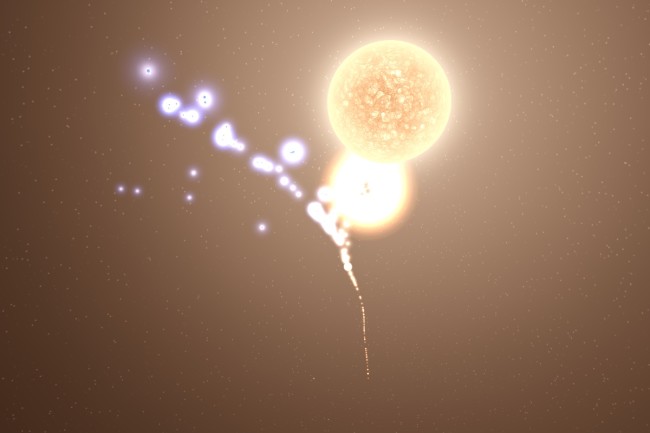
A Hertzsprung-Russell diagram in Universe Sandbox ² using the new stellar evolution model.
- Stellar Evolution
- Previously, we weren’t expecting this until after Alpha 20, but now it’s looking like we’ll have our new stellar evolution model ready for this update. With the rewritten model, Universe Sandbox ² will support 16 evolutionary star types versus the previous 5. Jenn, our astrophysicist, based the model on these papers; it is primarily a function of mass and age or metallicity, and will work for evolutionary types outside of main-sequence stars.
- The results will be more dynamic and accurate properties for stars, as well as smoother transitions from type to type. It will also now account for mass loss from solar winds, and be able to differentiate envelope from core.
- New User Interface System
- This is mostly just a change in the tech we’re using, but if you’re paying attention, you’ll notice some small changes to the design aesthetic as well. Also, if you’re on a 4k monitor and you’ve noticed that the text is a little hard to read at that resolution, then good news — the new interface is scalable for higher resolutions. It’s also an important step toward supporting language localization further down the road, and we know this is often requested.
- Analytics
- Analytics won’t change anything for users (at least not immediately), but it will help us better understand how people play Universe Sandbox ². We receive a lot of great feedback every day from our forums, social media, and in-game feedback system, but improving our analytics will allow us to see things like which sims are opened the most and which never are, or which options and features are never seen because they’re too hard to find or are confusing to use, or how many users close out of the tutorial after the second step. We’ll look at the data as a whole to see where our strengths and weaknesses are so we can focus our efforts on making the best possible improvements to the user interface and user experience. (And if you’d prefer to opt out of sending analytics, you can certainly do that as well.)
- Merged Desktop/VR Builds
- A small change for users (who will simply see one executable instead of two separate ones for desktop and VR), but an important step for the team. Along with merging these two separate “projects” internally on our development side, this will help keep the two versions up to par with each other in terms of features and improvements. And also with the help of Jacob, our new VR dev, this will make future VR updates a much smoother process.
- First Stage of Planetary Grids/Detail/Automata
- This is admittedly just a tease. You won’t see anything different on this front in Alpha 20. Our plan is just to take the first step in bringing in the necessary tech for this, which has existed in a separate development branch. But what is this nameless feature? Well, it’s actually a system that will open up the doors for a bunch of exciting features that will make planets visually more detailed and responsive to interactions. But we’ll have to wait until after Alpha 20 to see the first of these features in Universe Sandbox ².
What’s Coming After Alpha 20?
Find out in Part II of our 2017 roadmap!
And we really can’t say it enough — thanks to all of our fans for continuing to support Universe Sandbox ² as we enter another year. We’re very excited with all of the changes coming in 2017, and we’re incredibly grateful to our growing community for hunting down bugs and for helping define and prioritize our roadmap. Thank you for joining us on this crazy ride.
For the latest Universe Sandbox ² news, follow us on Twitter and Facebook.
Universe Sandbox ² 2016 Roadmap
Jan 27th
Happy New Year! 2015 was an exciting year for us. A few highlights: Universe Sandbox ² got a whole lot faster thanks to multiple physics refactorings, it was made a lot prettier thanks to a new user interface and a slew of eye candy upgrades, and we released on Steam Early Access with extremely positive reviews which haven’t stopped coming in.
The good news is that we don’t plan on slowing down. The following is a list of our hopes for Universe Sandbox ² in 2016.
It’s not necessarily a roadmap in the sense that we’ll get to these features in this order. But these are some of the big landmarks we are very excited to explore as we continue development through 2016 and beyond.
More Planetary Details & Interactions
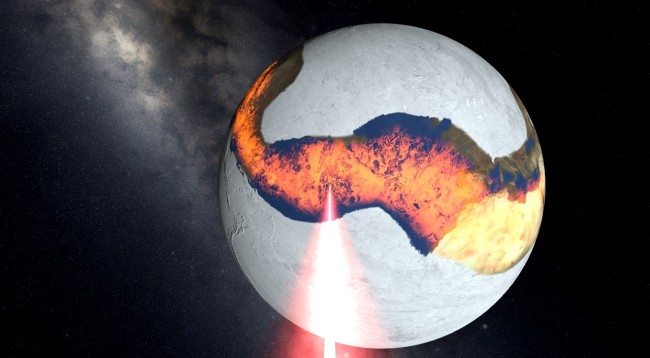
A laser melting a frozen Earth.
Planets in Universe Sandbox ² will be visually more detailed and responsive to interactions, all part of a project which we are internally calling “automata.”
This works by increasing the spatial resolution of data. That is, instead of having one point of data for an object’s property, like temperature, there will now be a 2D grid of data. In the example of temperature, this means that collisions can impact values locally, so heat spreads from the impact site rather than just raising the overall temperature. In turn, this will make for much more dynamic visuals. This will eventually also factor in elevation, making possible more detailed surface deformation and a lot more. And along with the improved composition system mentioned below, this will form the groundwork for basic life simulation.
Oh, and there will also be lasers.
Improved Composition System
Currently we support four materials for a body’s composition: iron, silicate, water, and hydrogen. We’ve been discussing ways we can include additional materials to this list. We’d also like to improve the interactions between radii and compositions, as the results are sometimes a bit confusing right now. Another component we’ve discussed is atmospheric composition. This is a very tricky problem with no clear solution, but it’s often requested and we are working toward it.
Space Megastructures
a.k.a. The Feature No One Knew They Wanted Until They Had It
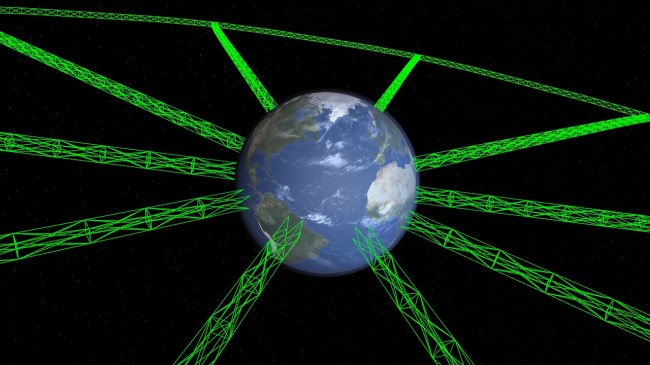
A megastructure around Earth. The green lines are the current, early rendering which will be improved.
We’re not ready to give away too many details on this yet… but doesn’t “Space Megastructures” sound pretty cool? The answer is yes, they do sound pretty cool, because they are. Using physics based space tethers as the idea behind the basic building block, these structures can come in many shapes and sizes. We still have a lot of work to do on these, but you can start imagining things along the lines of space elevators, Dyson spheres, and ring worlds.
Virtual Reality
What more needs to be said? Internally we have basic support for this going already, but there’s still a lot of work to do in fine-tuning the experience of reaching out, grabbing the Moon, then hurling it toward Earth. Our initial efforts are directed at getting it to work with the upcoming Steam VR based HTC Vive and the Oculus Rift.
User Interface Rewrite
This is largely an under-the-hood rewrite, but it’s going to make it possible to scale the interface for larger and different-sized resolutions, and also allow for language localization down the road. Technically, we’re transitioning from our own internal system to the new native system in Unity (our 3D engine) that didn’t exist when we started on this project 4 years ago.
Language Localization
As mentioned above, the rewrite to the user interface will make it a lot easier for us to implement localization. Our next step, once we’re ready, is to start the crowd-sourced localization process so we can get Universe Sandbox ² running in as many languages as possible.
Stellar Evolution Rewrite

A Hertzsprung-Russell diagram in Universe Sandbox ² using the new stellar evolution model.
Universe Sandbox ² will support 16 evolutionary star types with the stellar evolution rewrite , versus the previous 5. The improved evolution model, based on these papers, is primarily a function of mass and age or metallicity, and will work for evolutionary types outside of main-sequence stars.
The result will be more dynamic and accurate properties for stars, as well as smoother transitions from type to type. The model also will now account for mass loss from solar winds, and be able to differentiate envelope from core. As a whole, this is also a stepping stone toward being able to illustrate stellar nucleosynthesis in Universe Sandbox ². We’ve hit a few snags in fully implementing this, but Jenn, our astrophysicist, has been making good, steady progress.
Total Body Fragmentation
This feature was partially implemented before, but was removed during the physics rewrite. Now we’re about ready to add it back in, and once we add some nice visual flair, this will make collisions and explosions even more epic and realistic as planets get completely broken apart.
Improved Galaxies
We’ve been saying for a bit now that we’d like to give galaxies some love again, as they’ve been mostly overlooked recently while we work on other projects. Our plan includes completely reworking procedural galaxies, which tend to all look the same right now, and fixing a number of bugs which currently make galaxies a little difficult to interact with.
Atmospheric Scattering
We often see requests from users that the view from the surface (press “C” when focused on a body) could be improved. We completely agree. One big step toward this is accounting for the atmosphere (if the planet has one), resulting in nice colored skies, sunrises, and sunsets, all products of atmospheric scattering. This will greatly increase the immersion when looking up from one of your planets.
Steam Workshop
Once we get the save/load mechanics even more solid, we plan to add in support for Steam Workshop. This will allow users to easily share saved simulations and objects with each other, which will be a very cool way of seeing what everyone is creating with Universe Sandbox ².
Achievements
Steam Achievements are another common request for Universe Sandbox ². They can add a little incentive for exploring the simulation and trying things you wouldn’t normally try. Have any good ideas for Achievements? Let us know on the forum!
Expanded Climate Change Exploration
Our climate models for Earth and Mars have been successfully implemented in Universe Sandbox ² for a while. But we’d like to strengthen our focus on this component to further help educate users on one of the most pressing issues we face today as citizens of the Earth.
Mobile Version
Again, another common request for Universe Sandbox ². We haven’t yet moved beyond discussing this as a possibility, but we are very interested in a mobile version. Universe Sandbox ² could work extremely well with touch commands, and a mobile version would greatly increase the amount of people who could get their hands on it. With constant improvements to mobile technology, and Unity’s tools for building mobile apps (the 3D engine we use), this could be a reality sooner than we think.
Fixing Bugs
We’ve hired a dedicated tester whose job is to rigorously test Universe Sandbox ², helping us find and fix bugs as we continue development. We’re a small team, and the nature of a massive space sandbox means that there are an extraordinary amount of things to test. Our community has been super helpful to this end, but we’re happy to now have someone who’s devoted to this task and can help fill in the cracks.
The Future of Universe Sandbox ²
This roadmap may seem ambitious (and it is), but we’ve already gone pretty far into unexplored territory. We’re committed to making Universe Sandbox ² better and better as we continue to create something that’s never been done before. We hope you’re as excited as we are about the future.
Get instant access to Universe Sandbox ² on Steam Early Access:

